Last updated on March 26, 2024
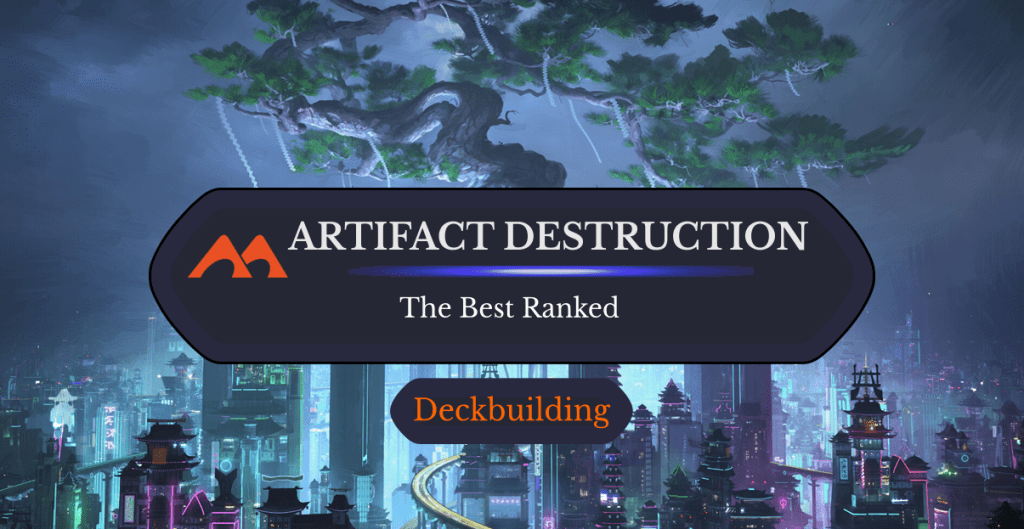
Boseiju, Who Endures | Illustration by Chris Ostrowski
Of all the card types in Magic, artifacts are arguably the most powerful. Not only is the Power Nine mostly artifacts, but some of the most broken cards I can think of are artifacts: Skullclamp, Umezawa's Jitte, and Smuggler's Copter all demonstrate the power of the card type before I even scratch the surface of fast mana like Mana Crypt and Sol Ring.
With so much power packed into a single card type, you need plenty of ways to interact with them—preferably by smashing them into pieces. Many small pieces. This is especially prevalent in EDH where decks pack all sorts of artifact-based combos and mana acceleration.
Let’s figure out the best artifact destruction spells in the game!
What Are Destroy Artifact Cards in MTG?
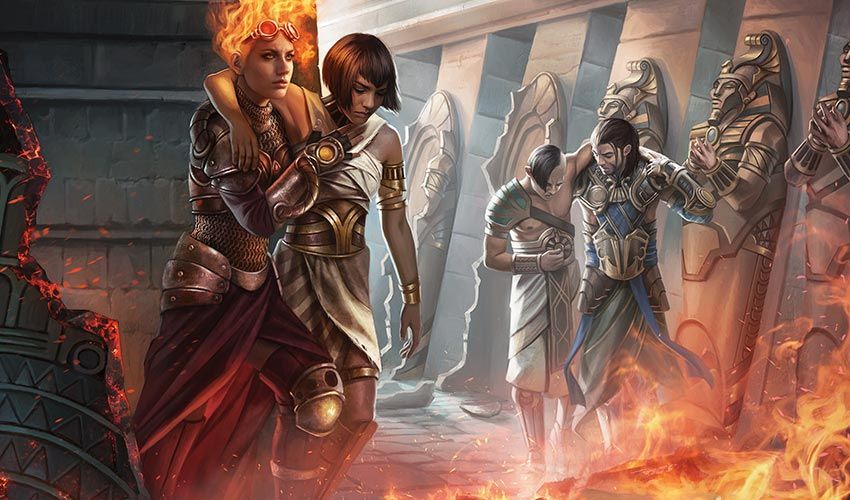
By Force | Illustration by Magali Villeneuve
Destroy artifact cards are cards with abilities that destroy or exile artifacts, otherwise known as artifact removal. Artifact destruction resides primarily in white, red, and green; black has practically no way to remove artifacts. Blue can bounce artifacts à la Steel Sabotage but rarely destroys them.
I’m looking for the most efficient or impactful artifact destruction spells. I want cheap and/or 2-for-1 cards here. I’m also being quite pedantic about what I’m adding, so I have more honorable mentions than usual. This list only considers cards that exile or destroy artifacts. This leaves out Assassin's Trophy, Abrupt Decay, and other “destroy target permanent” cards. These are powerful, and running enough of them can mitigate the need for the cards on this list, but they’re so flexible they would naturally top the list (I do have a few spells that target permanents other than artifacts, but they still say artifact).
I’ve also excluded cards that shut down artifact abilities: Collector Ouphe, Karn, the Great Creator, etc. These are powerful against specific artifact strategies, especially combo, but they don't destroy the artifacts.
I’ve also chosen not to include wraths that destroy artifacts in addition to other things, like Farewell or Akroma's Vengeance, because they occupy a different deckbuilding element; I did include some wraths that destroy just artifacts. None of the cards or effects I’m excluding are bad. They are strong. I just wanted to be specific about my inclusions. Finally, this list favors Commander, though plenty of Constructed all-stars appear.
#50. World Breaker

World Breaker isn’t bad. It’s just slow, and getting the maximum value out of it takes effort and specific deck building. Decks that can jump through those hoops likely should.
#49. Dreadmaw’s Ire
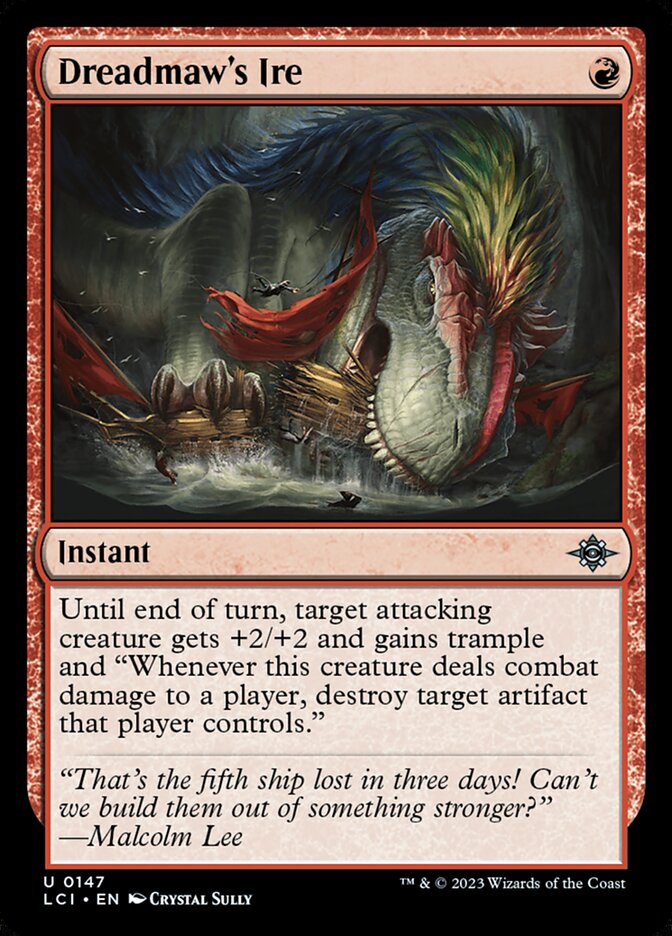
I don’t know that Dreadmaw's Ire is worth including in a Commander deck, but this has seemed pretty strong in Standard aggro decks. Perhaps the right commander, like Feather, the Redeemed, wants this.
#48. Rampaging War Mammoth
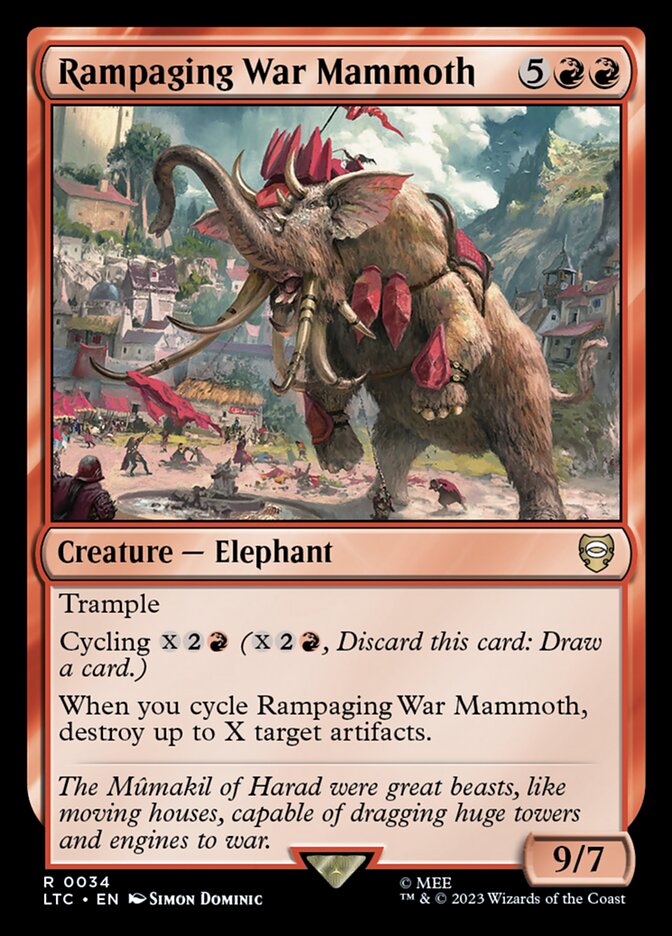
Rampaging War Mammoth acts as a modal card: You can play a fat beater or draw a card and destroy an artifact or two. Decks that care about discarding or the graveyard should consider this but either option seems expensive without synergy.
#47. Smash to Dust
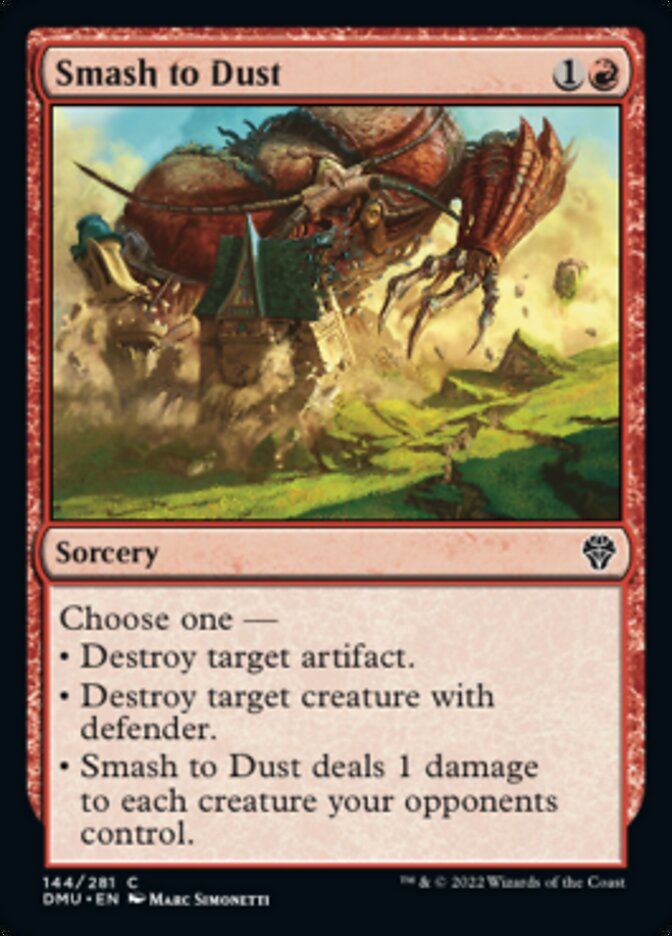
Smash to Dust is mediocre as a wrath or artifact destruction, but it can be respectable with commanders like Judith, the Scourge Diva or Tor Wauki the Younger that amplify the 1 damage into something more.
#46. Wave of Vitriol
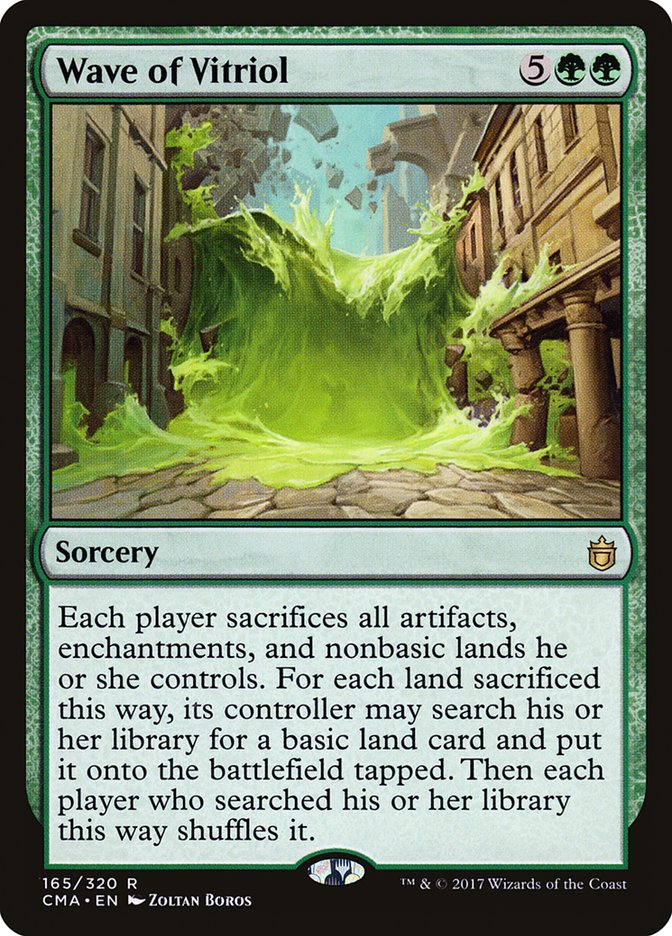
I just want to throw a Wave of Vitriol at a 5-color player. This card is incredibly expensive but effective, especially at punishing greedy mana bases. It’s probably not worthwhile unless you know people are jamming 4+ color decks or loads or artifact/enchantment strategies at the LGS.
#45. Storm the Citadel
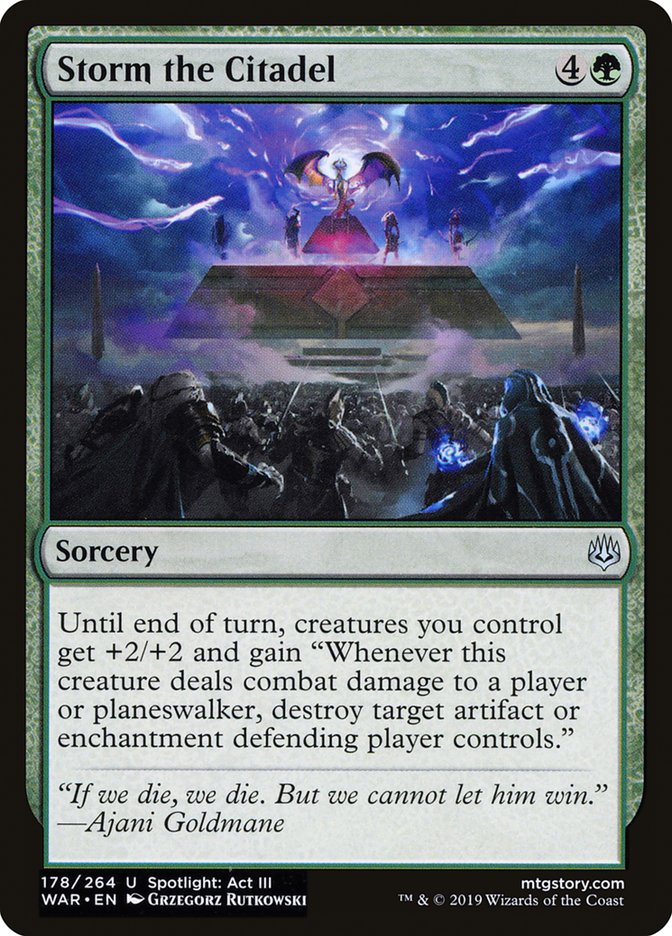
Storm the Citadel doesn’t give your creatures trample, so it’s a weak Overrun, but the destruction triggers make it an interesting, though potentially underwhelming option to destroy artifacts and enchantments in go-wide strategies.
#44. Unite the Coalition

Unite the Coalition has lots of good text, it really does… but it’s five colors and costs so much mana. Omanth, Locus of All and Jodah, Archmage Eternal thrive with this, but I don’t know if it goes anywhere else. These misgivings don't detract from its raw power.
#43. Broken Bond
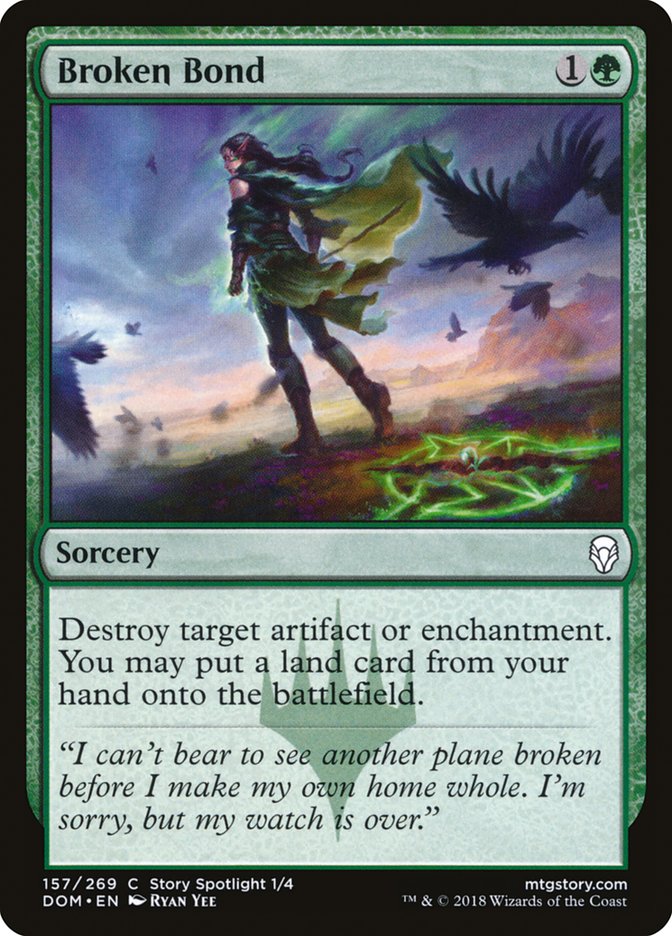
Artifact destruction and potential ramp make Broken Bond a perfectly respectable card, if unexciting. It’s a good fit with some landfall commanders.
#42. Artifact Mutation
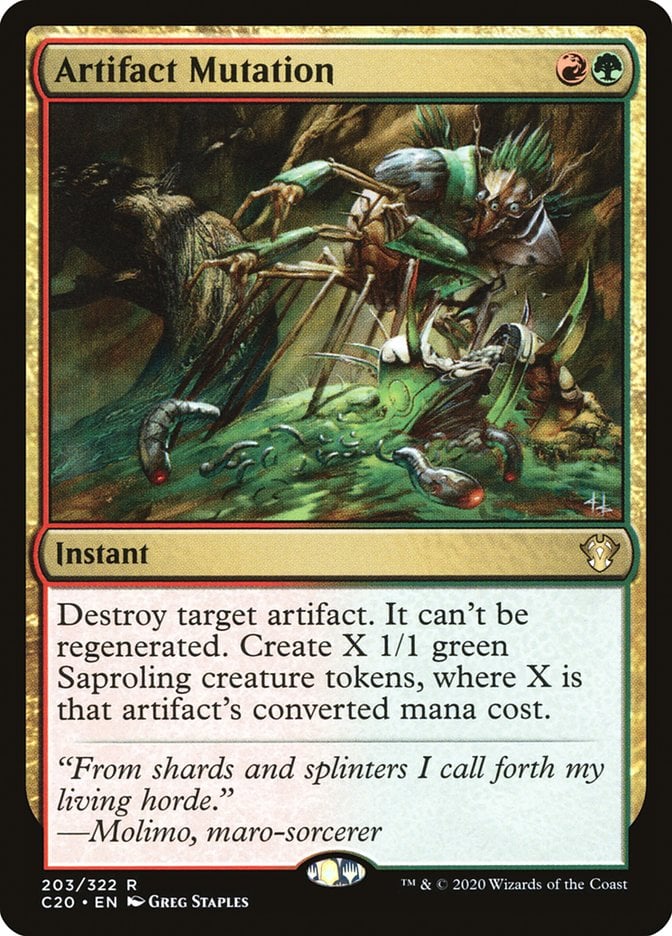
Token and Jund sacrifice decks can get a lot of mileage from Artifact Mutation, though I don’t know about running it outside those shells. It has good potential and a high ceiling, but the floor is lower than I’d like for my artifact removal.
#41. Cindervines

Cindervines has more value as a stax piece punishing storm and adjacent strategies, though the bonus of destroying artifacts is a nice touch.
#40. Gorilla Shaman

Pauper decks get tons of use from Gorilla Shaman destroying affinity’s artifact lands. It could be useful in other formats paired with cards like Agatha of the Vile Cauldron that reduce the cost of the activated ability.
#39. Seal of Cleansing + Seal of Primordium
Seal of Cleansing and Seal of Primordium are the same card, just color shifted. As such, they have the same strengths: Either’s great in an enchantress list or a list that can recur permanents, and neither really belongs unless a deck can do those things.
#38. Space Marine Devastator
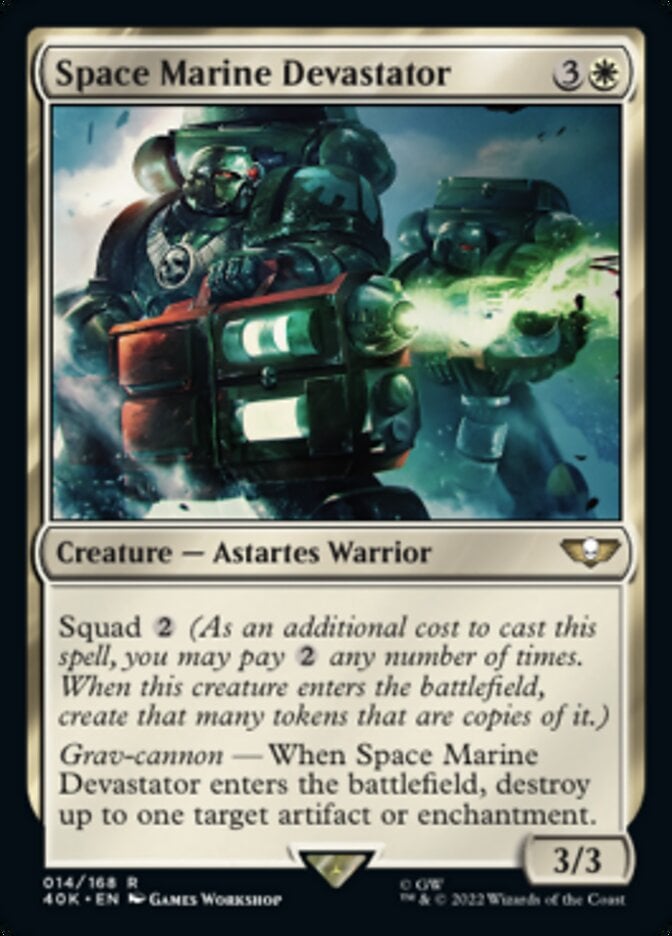
Space Marine Devastator is pretty mana-intensive, but decks capable of doubling tokens or ETB triggers will enjoy its power.
#37. Sundering Growth

Sundering Growth works incredibly well in token-centric decks as a 2-for-1; it’s unplayable outside of them.
#36. Consulate Crackdown
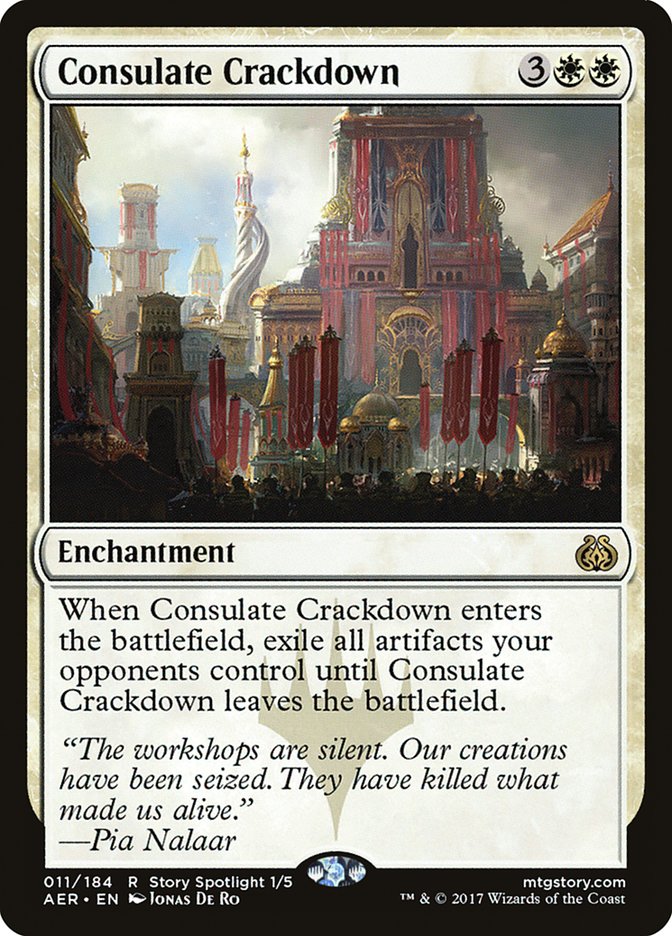
Getting to Oblivion Ring all opposing artifacts does a lot of work, especially against tokens. But you need to hit more than random mana rocks for Consulate Crackdown to be worth the 5 mana, and it has the weakness of all O-Ring variants.
#35. Dissenter’s Deliverance
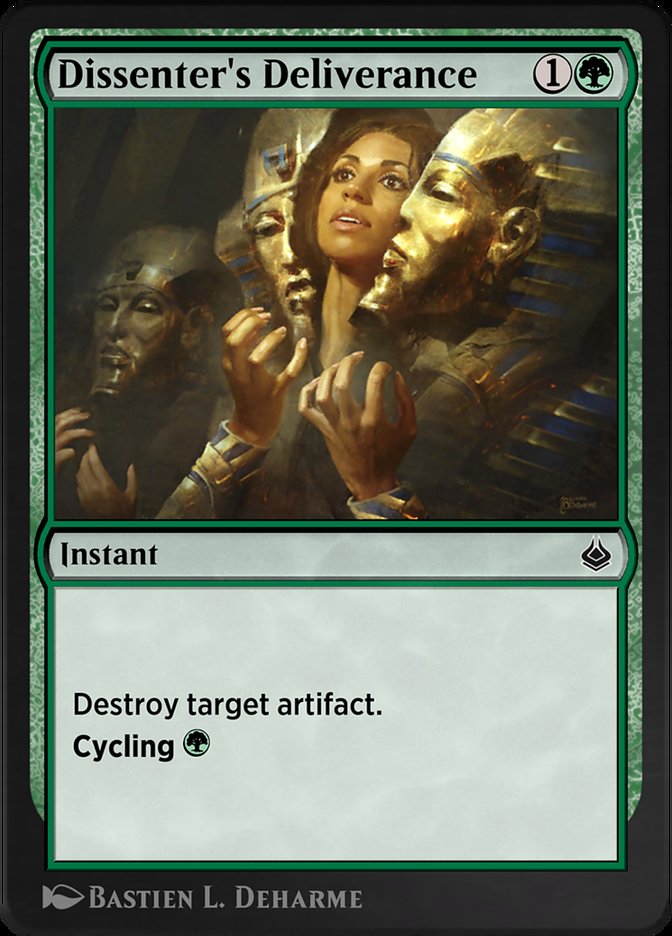
Dissenter's Deliverance is Fine with a capital F. Being situational—that is, requiring your opponent to have an artifact worth killing—is an inherent weakness of artifact removal, which is why flexible removal that hits multiple card types gets valued highly. Cycling when this is a dead card isn’t as strong as killing something else, but it’s not bad.
#34. Sylvan Reclamation
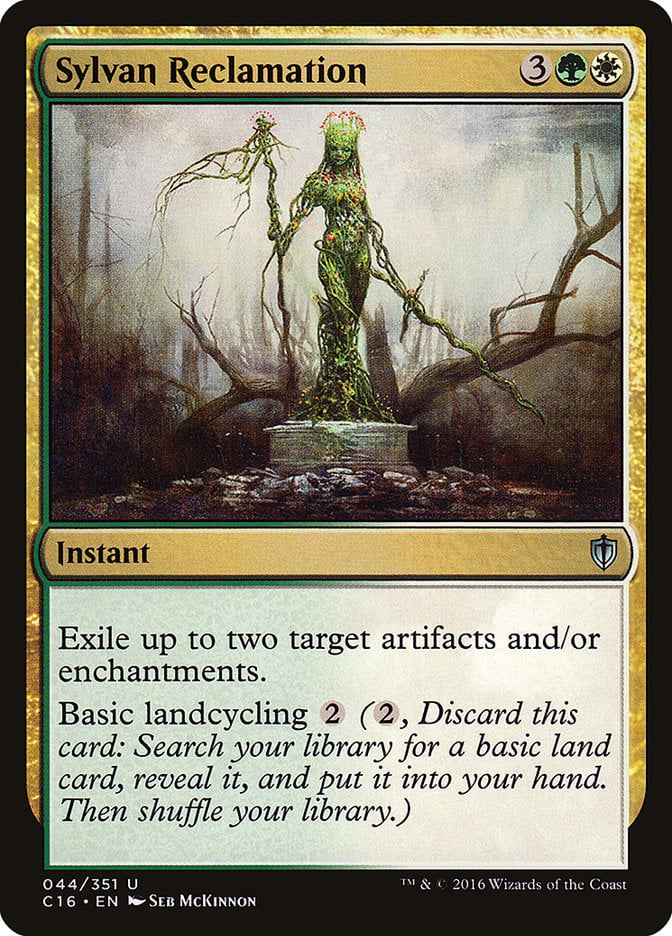
Sylvan Reclamation works best at slower, lower-powered tables where you have time to utilize slow fixing or an equally slow 2-for-1. Don’t run this if most people in your playgroup restrict their artifact/enchantment usage to 1- and 2-mana ramp spells.
#33. Dismantling Wave

The 3-mana 3-for-1 Dismantling Wave is a perfectly respectable card from Commander 2020. The flexibility of cycling for an admittedly narrow wrath pushes this into the realm of playability, though it’s still not ideal for all decks.
#32. Acidic Slime
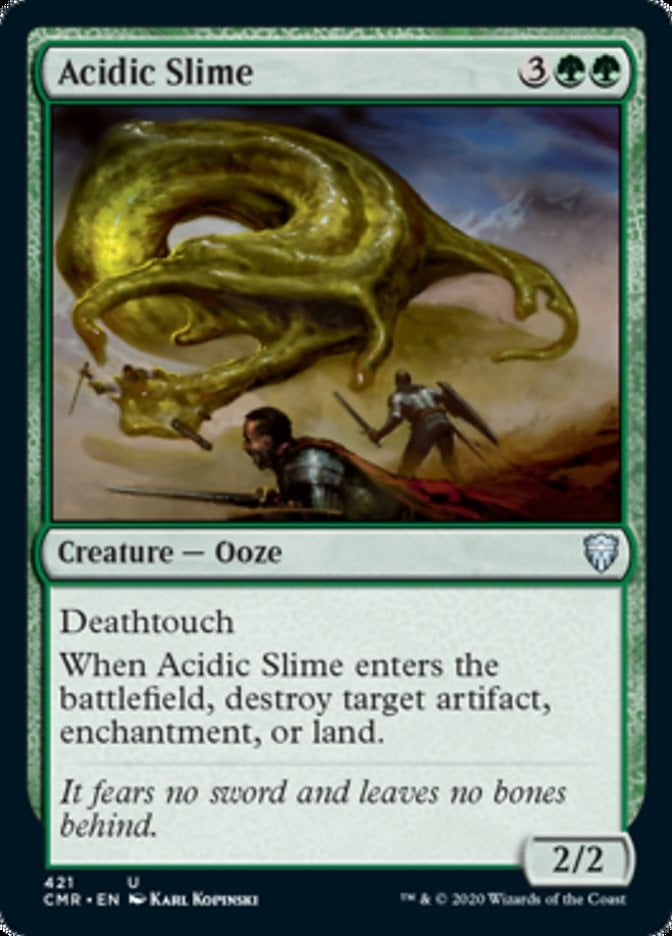
An oldie but goodie, Acidic Slime performs best alongside frequent flicker effects. It’s great at removing problematic lands like Blast Zone or man-lands, and flickering it infinitely is a great way to lose friends.
#31. Hull Breach

I think Hull Breach is a meta call. If your playgroup regularly mixes artifacts and enchantments, this provides an excellent 2-for-1. If they don’t, you have better options.
#30. You Find Some Prisoners
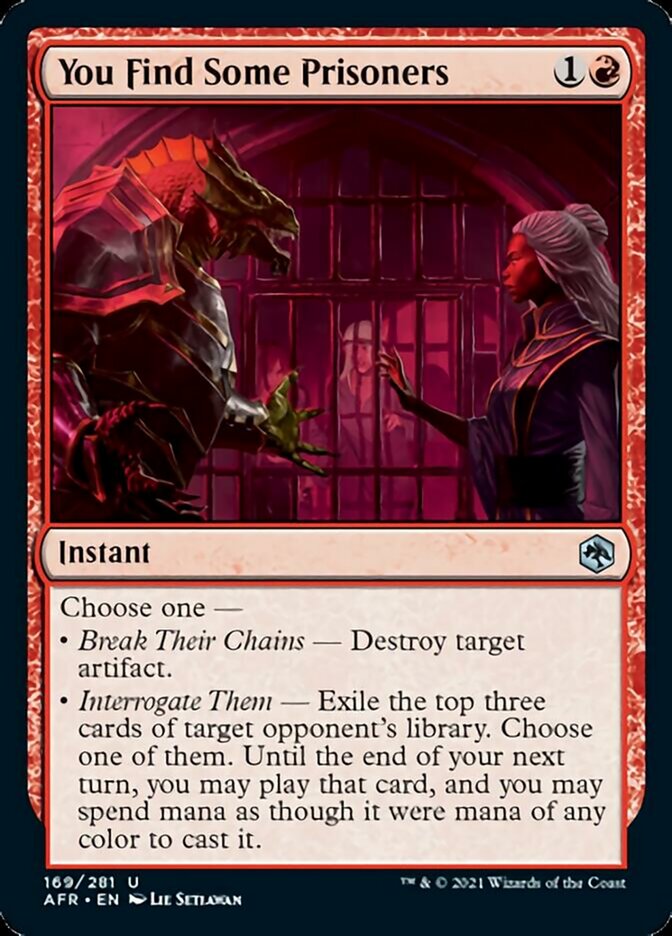
You Find Some Prisoners from Dungeons & Dragons: Adventures in the Forgotten Realms is a wonderful example of the flexibility I value in my interaction. Killing a prominent threat is deece, and it can draw a card in a manner synergistic with cards like Prosper, Tome-Bound or Don Andres, the Renegade.
#29. Rakdos Charm
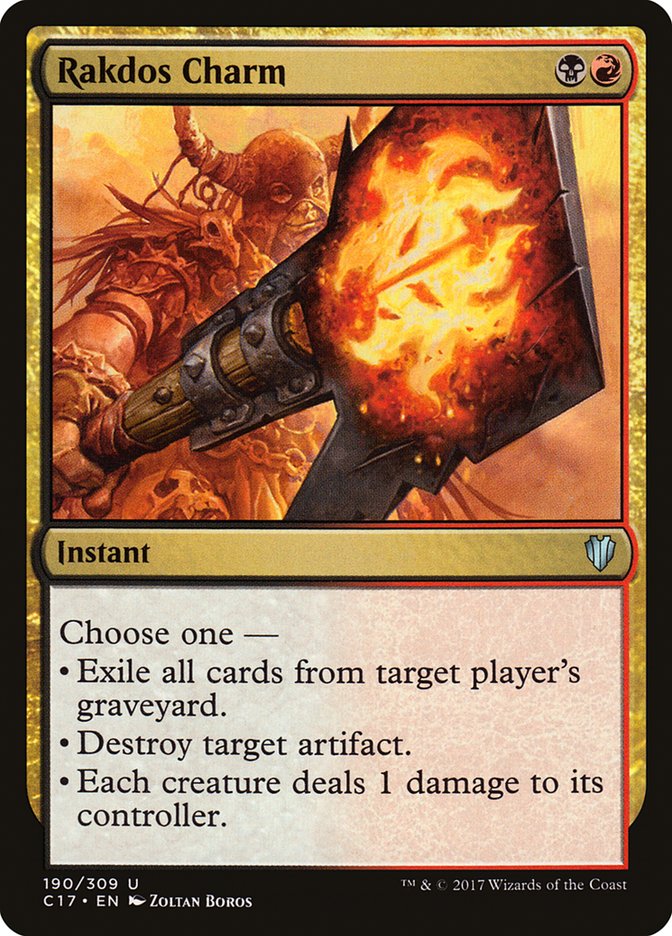
Rakdos Charm offers a flexible hate piece, striking down graveyards and artifacts. It can be a sneaky late-game win condition or punish players who make infinite creatures with cards like Kiki-Jiki, Mirror Breaker and Splinter Twin.
#28. Aura of Silence
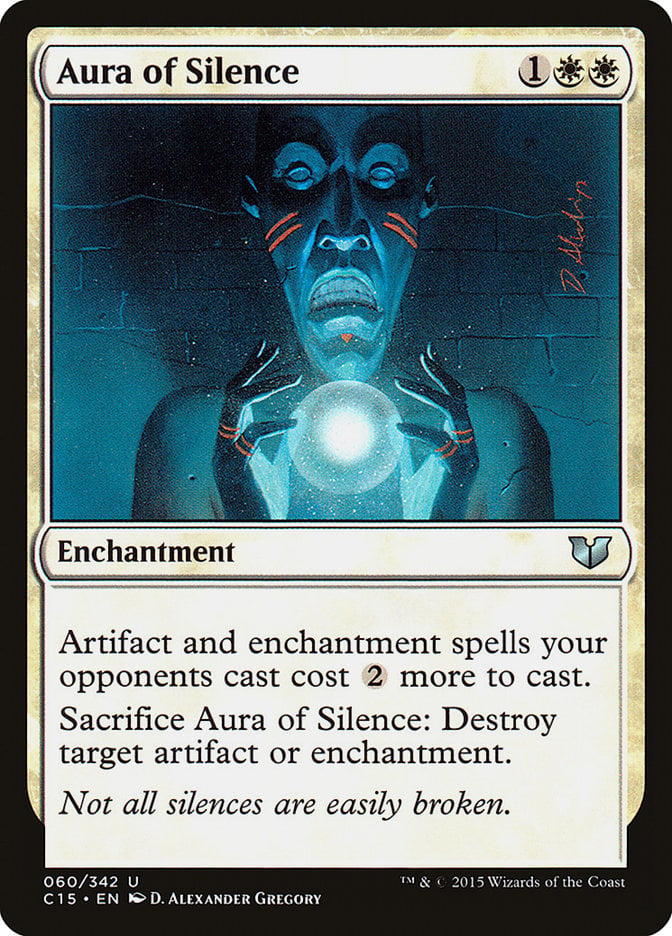
I love taxing my opponents. Aura of Silence shuts some decks down when you play it early. It cripples enchantress decks and many non-green EDH lists that rely on talismans and signets for acceleration. Getting to cash it in for a card later makes this card well-rounded. The main issue with Aura of Silence is that it’s an absolute dud in some matchups.
#27. Hopeful Initiate

Hopeful Initiate is squarely a synergy card. It’s great in a deck with +1/+1 counters to spare, but don’t rely on its training ability alone to get those counters (speaking towards EDH, at least). This is still a strong 1-drop in Standard.
#26. Silverback Elder
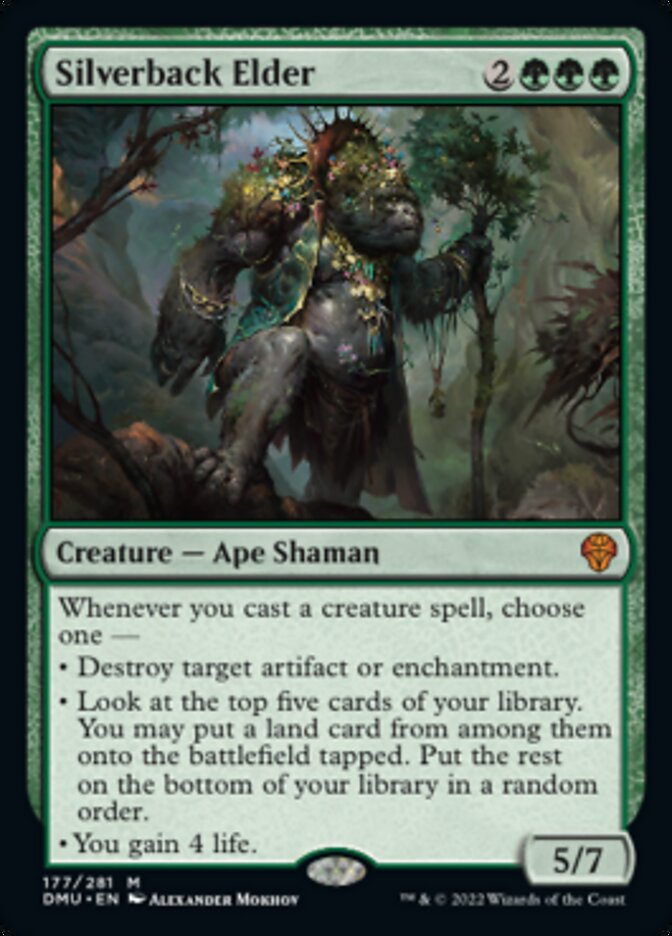
Silverback Elder has some stiff color requirements. I still like it; turning each creature you cast into a ramp spell or Reclamation Sage does a lot of work in the right deck.
#25. Ashes to Ashes + Rack and Ruin
Between Ashes to Ashes and Rack and Ruin, I prefer exiling with Ashes. But both are just fine as a 3-mana 2-for-1.
#24. Druid of Purification
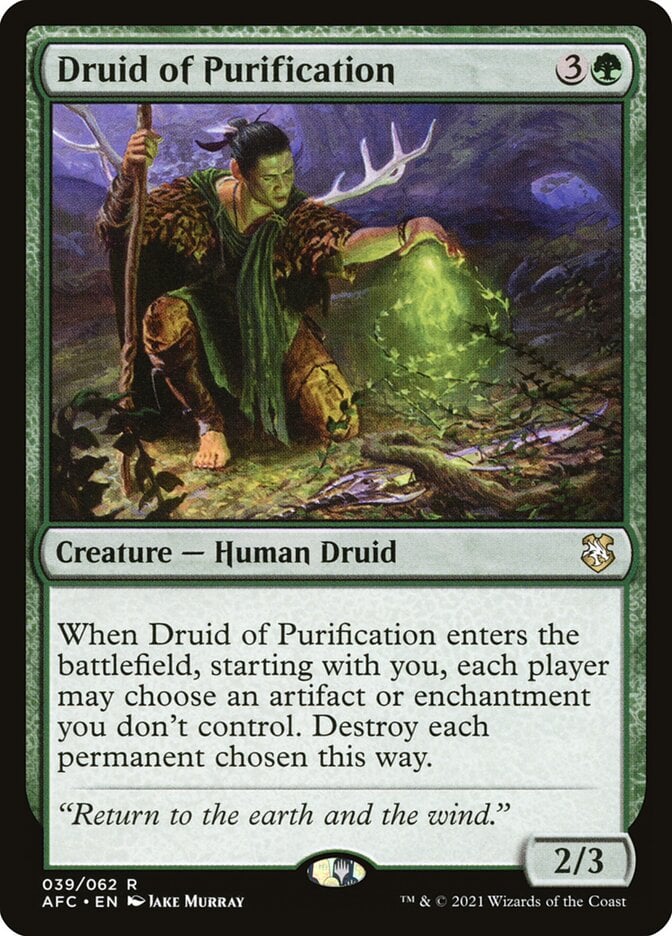
You’ll never see Druid of Purification outside of Commander (and that one Legacy list that’s gonna win something to prove me wrong), but it’s great in that format. Not only will it (typically) kill multiple permanents and synergize with flicker effects, but it opens the door to lots of politicking that can form alliances.
#23. Fiery Confluence

Killing three artifacts is sick, killing small creatures is good, and doming opponents for 6 damage can end games. Mixing all three effects makes Fiery Confluence a well-rounded spell that handles a lot of threats.
#22. Seeds of Innocence
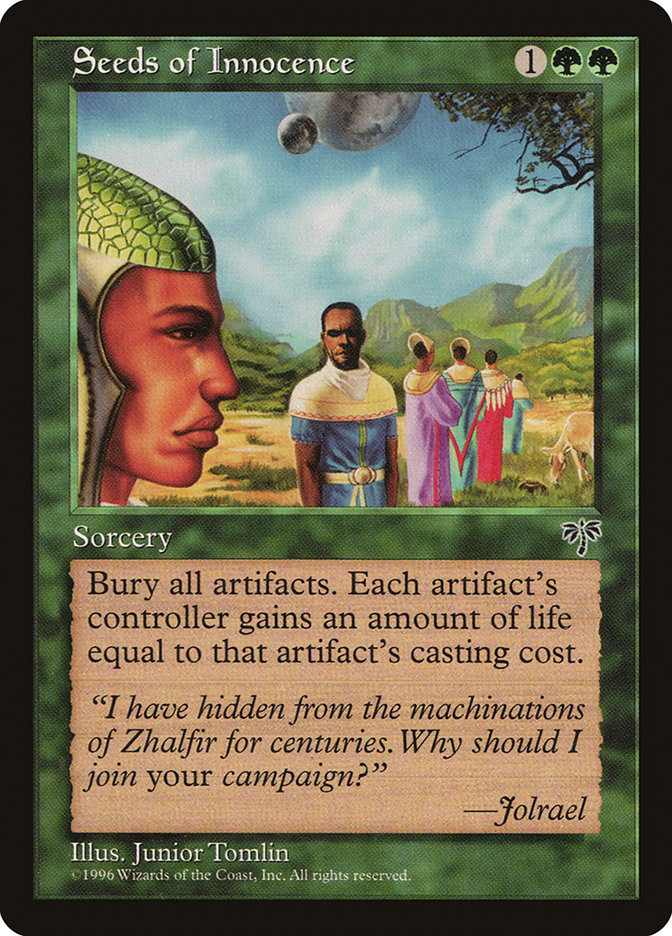
Seeds of Innocence provides a cheap wrath but giving your opponents so much lifegain can be a downside. I'd want to play this in combo decks that win the game with infinite loops or Thassa's Oracle rather than standard combat damage.
#21. Abrade
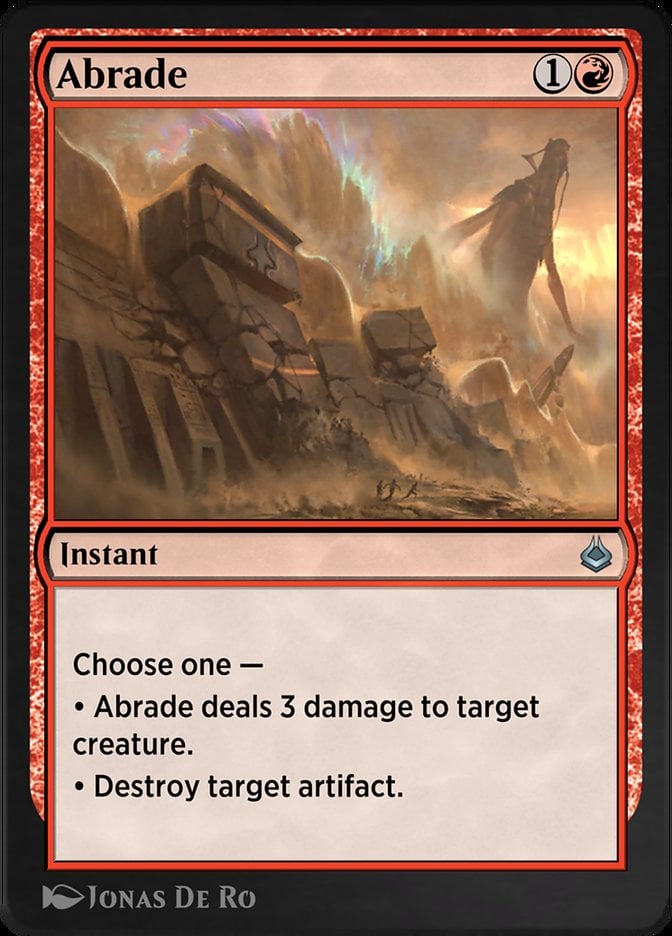
Abrade works. It’s that simple. mana to kill a small-medium creature is fine, as is destroying an artifact. There’s nothing flashy on this oft-reprinted Hour of Devastation card, but not every card needs pizzazz.
#20. Bane of Progress
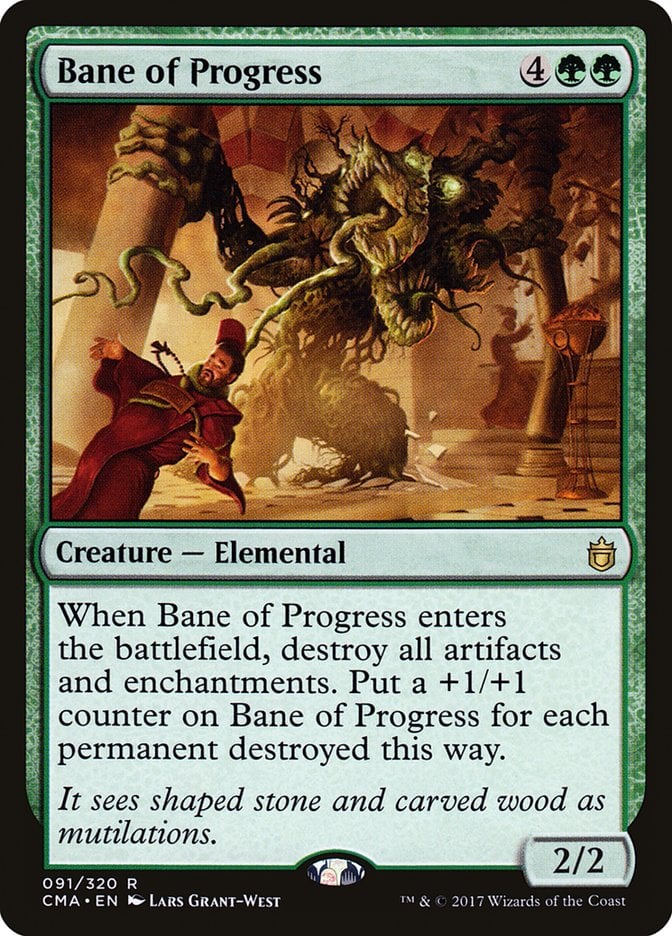
Bane of Progress is among the many cards that have seen their EDH heydays pass as the format (and game) becomes sleeker and more efficient, but this can still be a respectable threat. It plays well with tutors like Natural Order and Chord of Calling to play it at the optimal time.
#19. Foundation Breaker
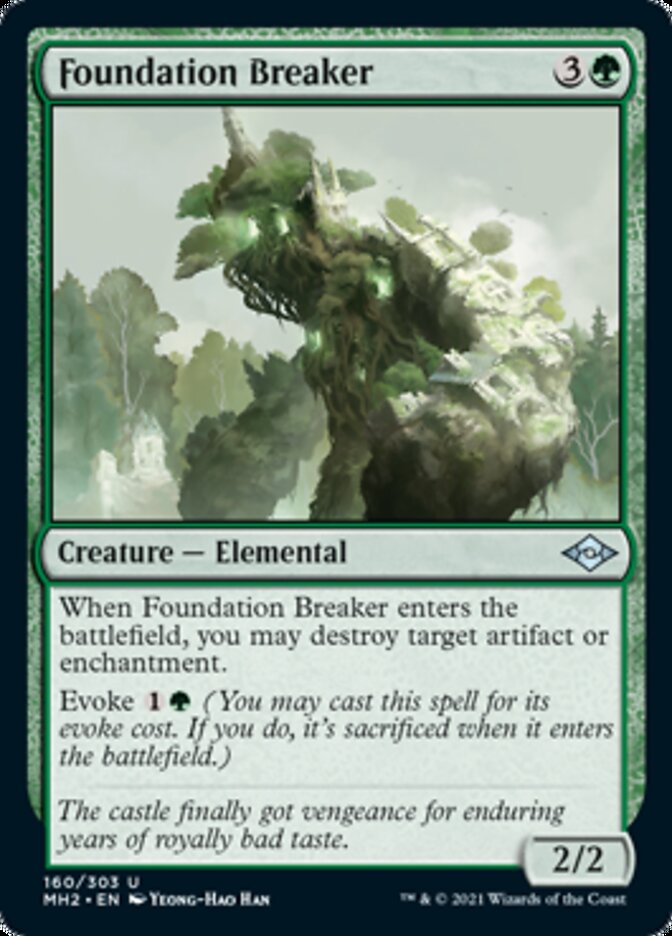
I love Foundation Breaker. An artifact destruction spell that puts a creature in the yard works amazingly with all sorts of commanders, like Meren of Clan Nel Toth and Korvold, Fae-Cursed King.
#18. Rip Apart
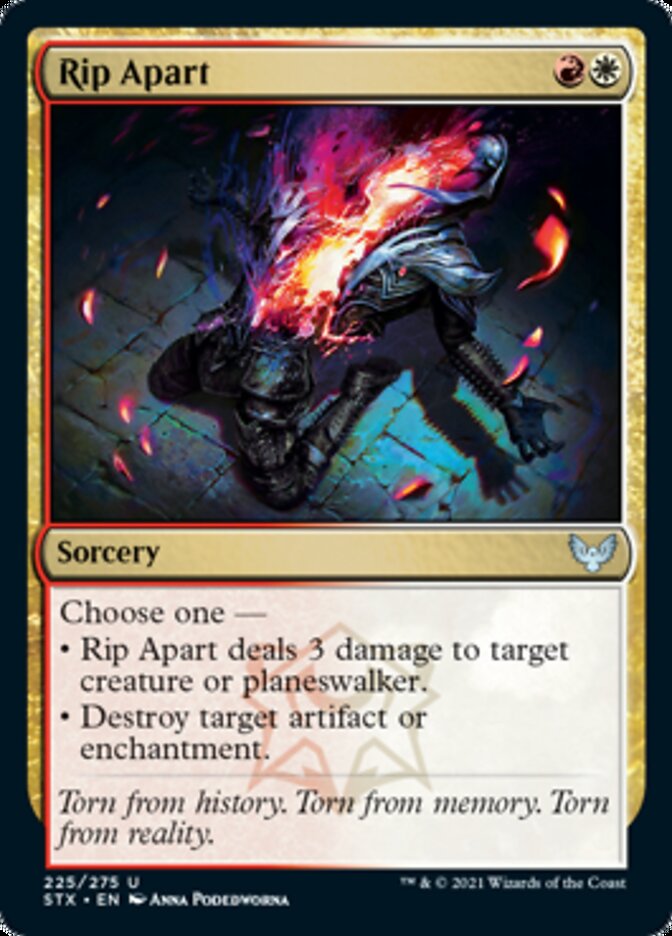
Why yes, I’ll take a more flexible Abrade at the cost of needing to be in +. Rip Apart is a prime removal spell on flexibility alone, and it typically trades up in mana.
#17. Dauntless Dismantler

Dauntless Dismantler combines the slowing power of a stax piece like Manglehorn with an activated ability the blows up lots of artifacts. This card handily answers Treasure-heavy strategies and may prove even more useful in the future as a hate piece.
#16. Cathar Commando

Cathar Commando is just good value! Aggressive decks get a lot out of a 3/1 with flash, various flavors of aristocrats love a cheap creature that sacrifices itself, and any deck can use a 2-drop that stays relevant throughout a game.
#15. By Force
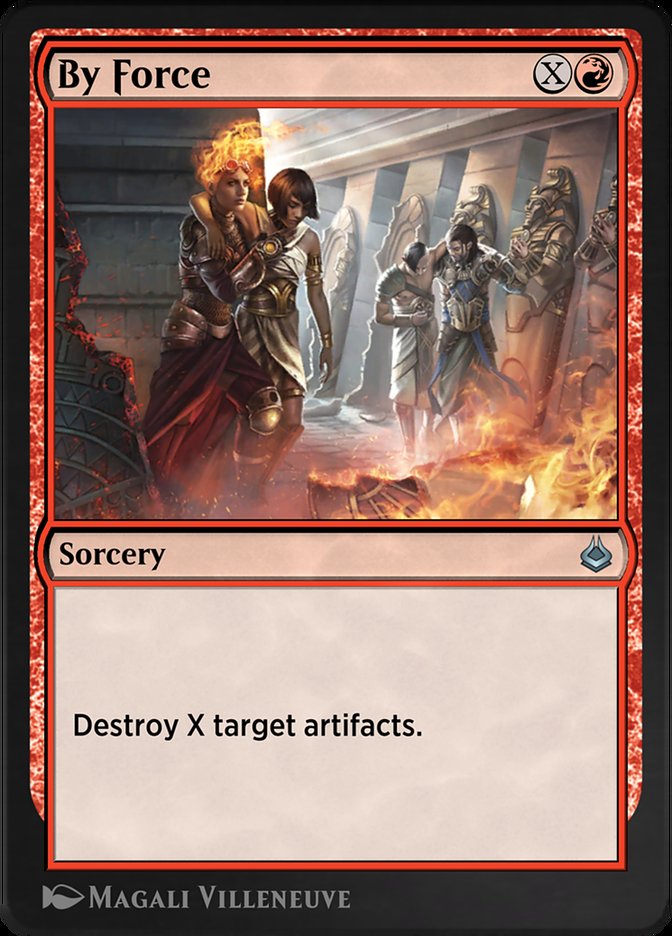
By Force gives you what you pay for—literally. It scales with the game pretty well. to kill an artifact is fine, to kill 2 is a decent rate, and it gets better. This works best in + decks with plenty of mana to spare.
#14. Brotherhood’s End
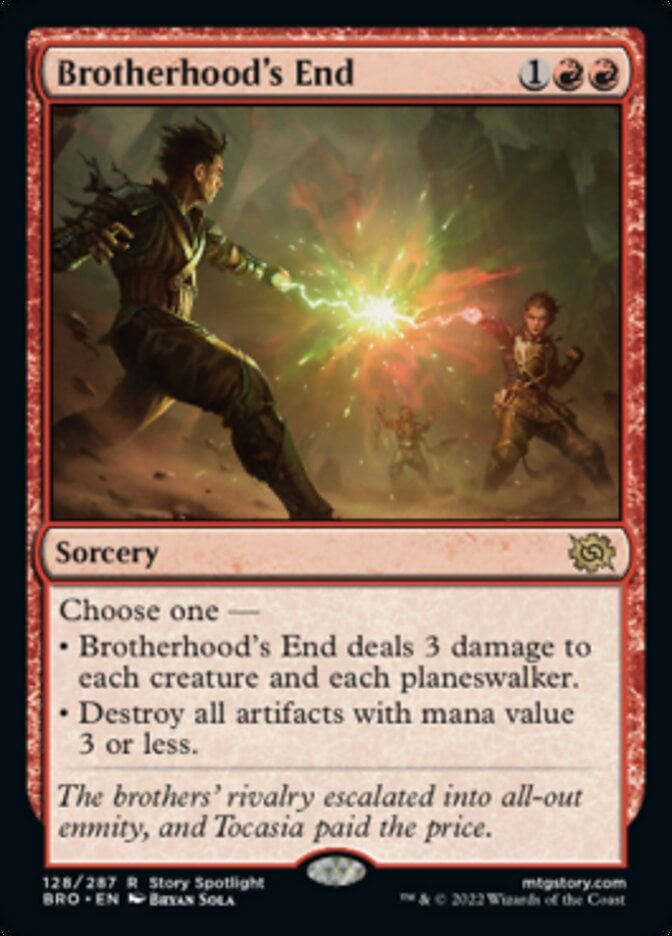
Hello, flexibility! Brotherhood's End handles creatures or artifacts, whichever hampers your progress. This is another one I like in Gruul; I’ve had lots of success dumping a bunch of mana dorks into play and then sweeping aside the mana rocks.
#13. Haywire Mite
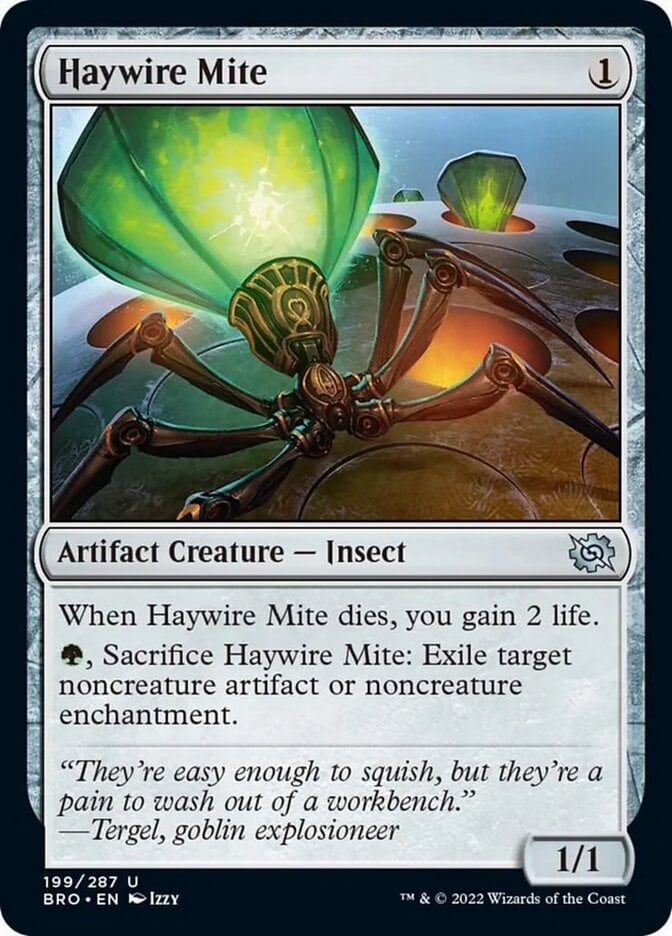
Look at this little guy! What a role player. Only exiling noncreatures is a touch restrictive, but it’s well worth the cheap cost, plus Haywire Mite synergizes with any cards that want cheap creatures or artifacts to go to the graveyard, and Urza's Saga or Trinket Mage find it. It’s not for every green deck, but many can leverage it.
#12. Archdruid’s Charm
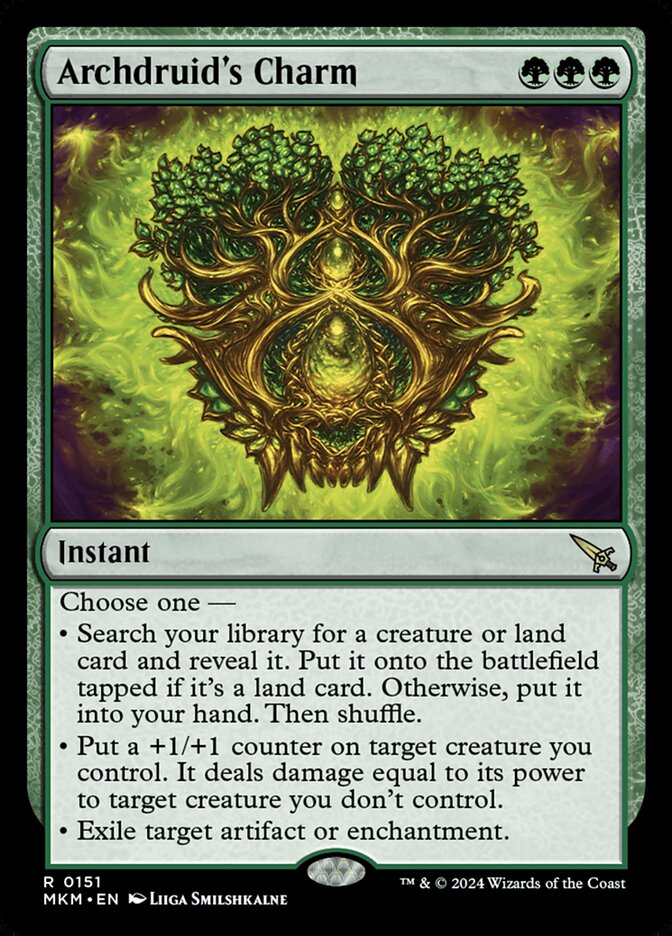
is a hyper-restrictive cost that prevents most decks from playing Archdruid's Charm. You can’t ask for much more flexibility than a modal spell like a charm that kills artifacts, enchantments, or creatures, or even tutors a card.
#11. Manglehorn
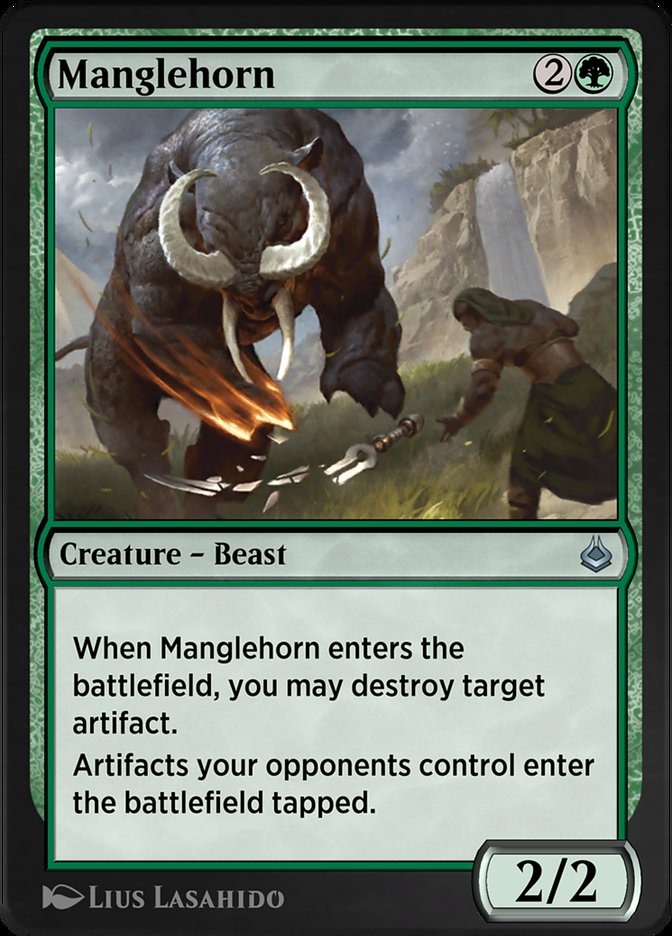
Manglehorn shuts down Treasure decks. That, and it shuts down a variety of combos utilizing Dockside Extortionist and similar cards.
#10. Reclamation Sage + Loran of the Third Path
Reclamation Sage has been a Commander staple forever and with good reason. Loran of the Third Path is stronger by having the same ability plus more text, but both are perfectly respectable, especially in decks that can flicker them.
#9. Meltdown

Meltdown kills lots of permanents, and you can protect some of your stuff. It works best in high-powered EDH tables where it wipes away all manner of fast mana, from Chrome Mox to Mana Crypt (and Treasure) for a minimal investment, though obliterating talismans and such for a higher cost is still solid.
#8. Pest Infestation
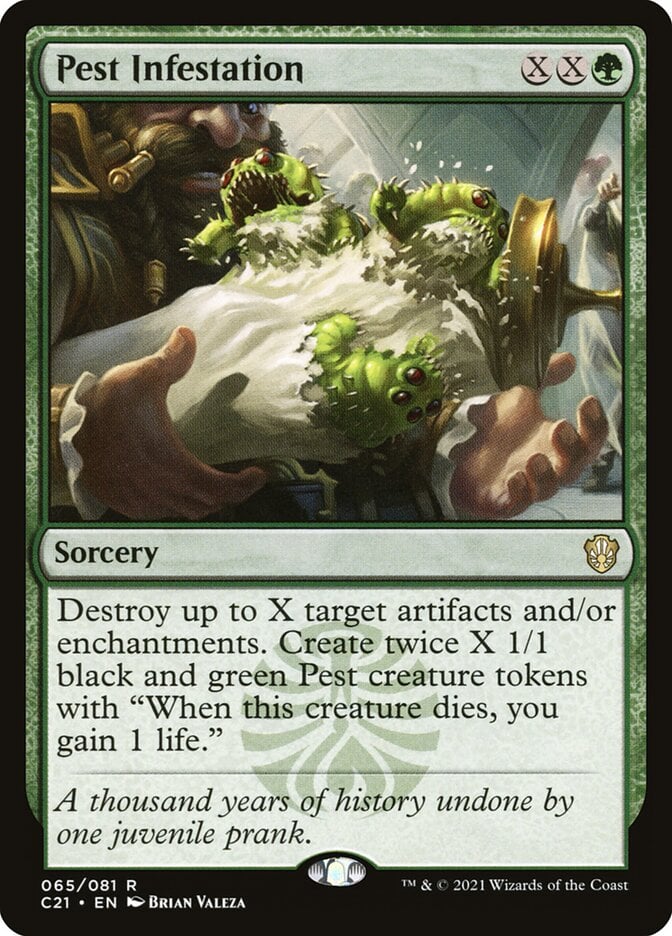
You need to sink some mana into Pest Infestation, but it’s worth the investment. Many decks can do a lot with tons of tokens dumped into play, especially since this is a 6-for-1 or some nonsense.
#7. Nature’s Claim
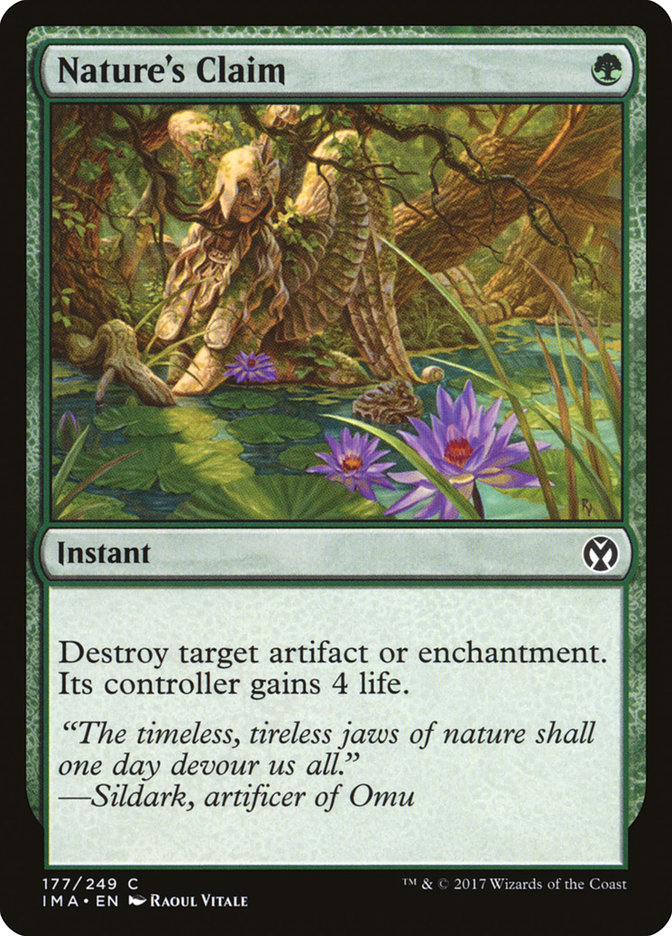
The king of efficiency, Nature's Claim virtually never trades down or even in mana. It’s all upside, baby. Except for that 4 life. If your deck wins by a high enough margin, either because Craterhoof Behemoth sends you over the top or your win conditions aren’t related to combat damage, it doesn’t matter. If you’re running an aggressive deck that wins by thin margins, you may want to look elsewhere.
#6. Tear Asunder
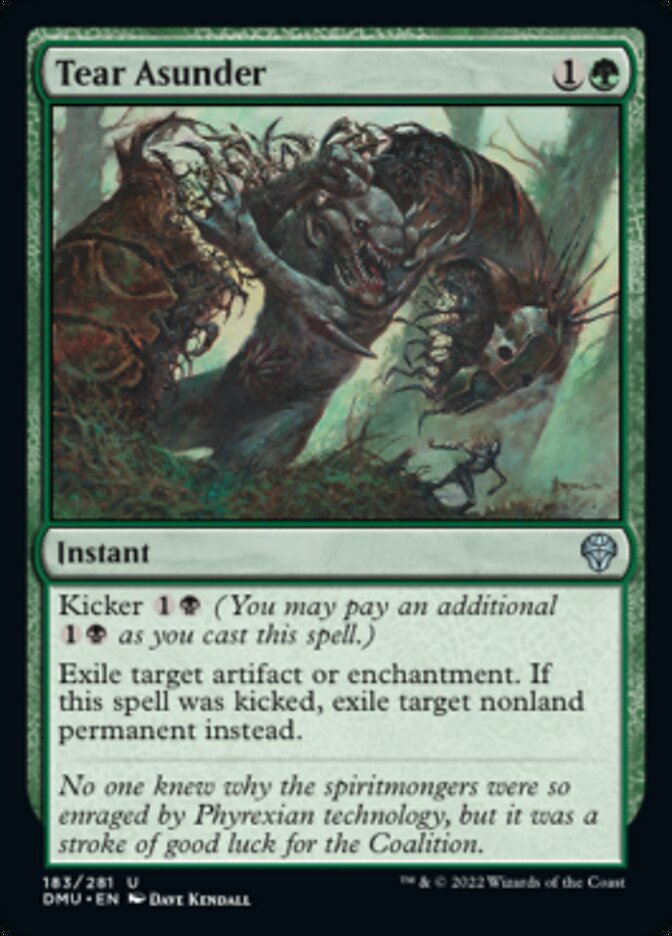
2 mana to exile an artifact? Great! 4-mana to exile any nonland? While I wouldn’t jam Utter End into most decks, the flexibility makes the card. Spending 2 mana to kill Rhystic Study or The One Ring or 4 to handle more present threats makes Tear Asunder relevant at virtually every point of the game.
#5. Prismari Command + Kolaghan’s Command + Flame of Anor
I don’t think I’ve written a list that Prismari Command or Kolaghan's Command qualify for and not put them in the top 10. That’s how strongly I feel about these command cards. Flame of Anor isn’t quite that good since you need a wizard, but it’s close enough to lump them all together. Look, all three of these cards are good for the same reason: They have lots of text and give you multiple options, and it’s all good. These are the height of flexibility.
#4. Vandalblast
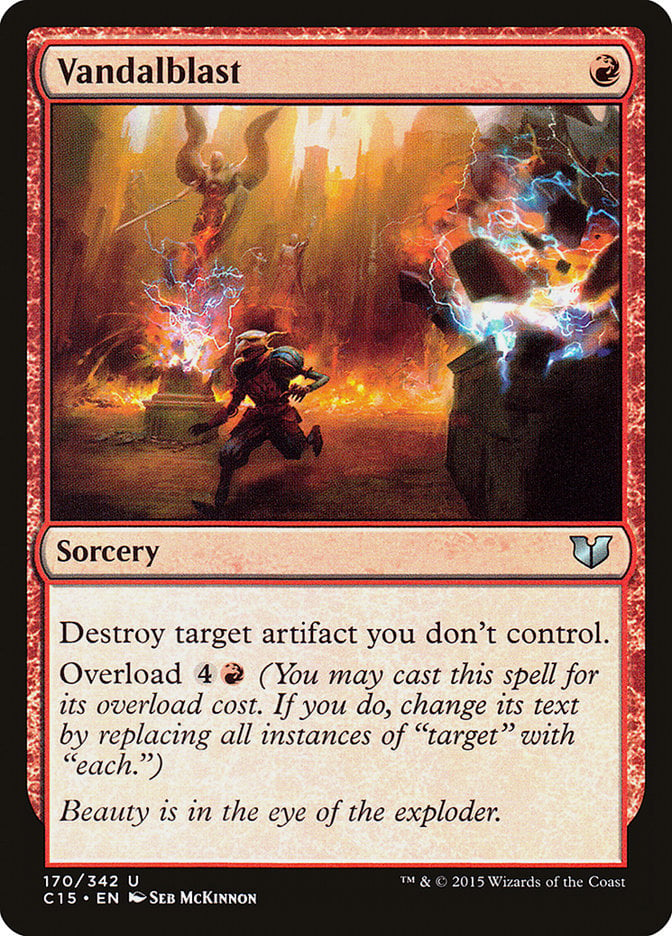
It’s time to brush off your Mycosynth Lattice! Vandalblast deserves its status as a long-time EDH staple. to kill one thing is a totally fine 1-for-1 trade that’s often favorable on mana. Wiping away all artifacts for is efficient, especially as your cards aren’t at risk.
#3. Aura Shards
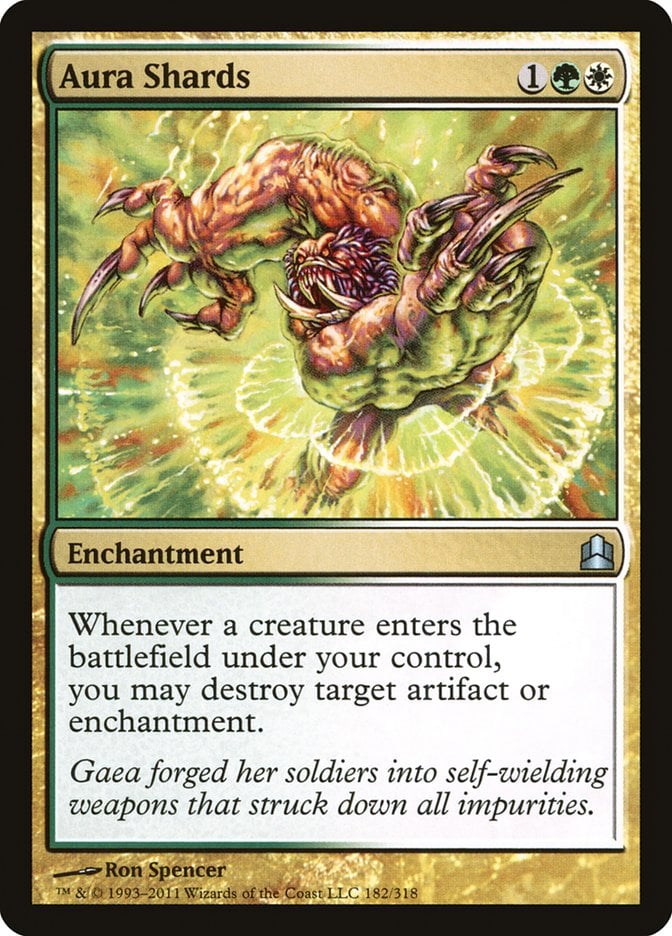
Potentially the most obnoxious choice on the list, virtually any deck benefits from Aura Shards. Any deck putting creatures into play loves the incidental destruction. Why play one Reclamation Sage when your entire deck can be Reclamation Sage?
#2. Force of Vigor

This just in: Free spells are good. Pitch spells like Force of Vigor get balanced around 2-for-1ing yourself when cast for free, but this goes even on cards for some reason? Wasn’t that what got Fury banned? Whatever, we’ll take it. Not only does this go even on cards when cast for free, but it’s just a 2-for-1 when you cast it fairly. It kinda does everything.
#1. Boseiju, Who Endures
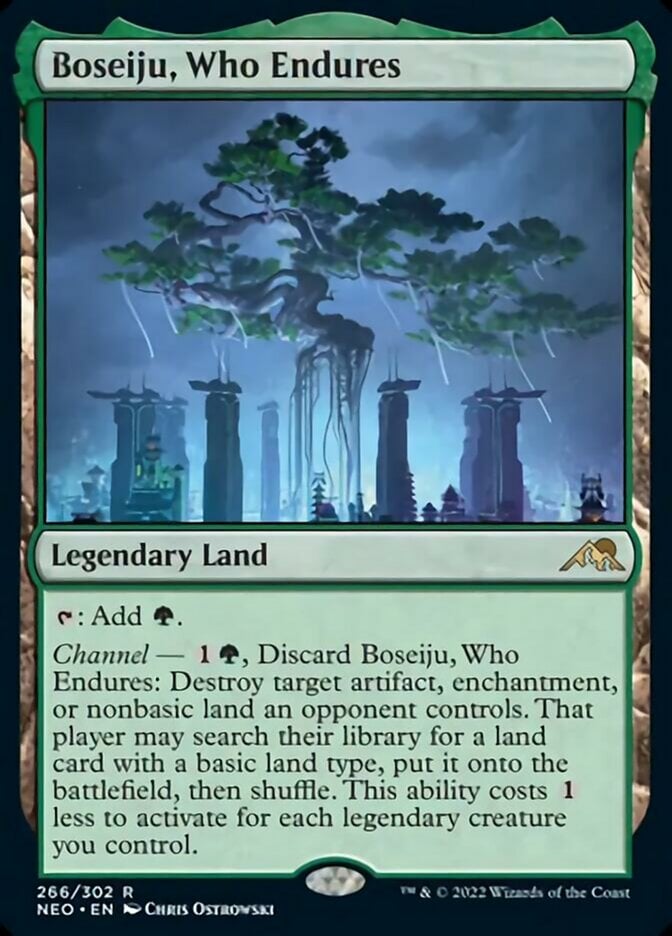
Since its release, Boseiju, Who Endures has made it into every green EDH deck I’ve built and will continue to do so. First up, flexibility in the mana base is fantastic in EDH and Magic in general. You need plenty of lands to play spells but don’t want to flood; these make cards that can be lands or spells quite valuable.
Next up, you aren’t casting a spell. You’re activating an ability from your hand. The biggest benefit to this is it makes it harder for your opponents to interact. They can Swan Song that Nature's Claim, but very few decks run the Stifle effects necessary to counter an ability. Activating an ability like this also skirts effects that might restrict your ability to cast spells like Archon of Emeria or Silence.
There’s even more flexibility here since you can get rid of nonbasics lands, handling threats like Mutavault + The Book of Exalted Deeds or Minas Tirith. Of course, there's the downside of this card giving your opponent a land. That just means you can’t blow this on a talisman or something dorky. Save it for Rhystic Study or Isochron Scepter, something that’s worth giving your opponent an extra mana so you don’t need to deal with it.
Best Artifact Destruction Card Payoffs
Interaction is powerful enough that you don’t need much payoff, but you can maximize it. The best way to do so is to turn opposing permanents into artifacts. You can do it to all of them with Mycosynth Lattice or targeted effects from cards like Liquimetal Torque.
Once you’ve turned an opposing permanent into an artifact in addition to its other types, you get to destroy their permanents like any old artifact. This can be a great way to use Nature's Claim and other such cards to remove the best planeswalkers, creatures, and even lands at an incredible discount.
How Do You Deal with Artifacts in Magic?
You have multiple options when dealing with artifacts. The choices on this list focus on destroying or exiling them from play. Another choice is to shut them down with cards like Stony Silence and Collector Ouphe that prevent artifacts from activating abilities. Finally, options like countermagic and discard spells can handle artifacts (and many other threats) before they even impact the board.
Can You Kill an Artifact Creature?
Yes! Unless otherwise specified (such as on Haywire Mite) artifact destruction cards kill artifact creatures, artifact lands (Ancient Den), and artifact enchantments (Bident of Thassa). Any permanent with multiple types can be targeted by spells that destroy one or more of those types so artifact creatures can die to both Nature's Claim and Infernal Grasp.
Is An Artifact Equipment Destroyed When a Creature Dies?
No. When a creature dies, any equipment attached to it remains on the battlefield, no longer equipped to anything. Some cards like Turn to Slag, Fires of Mount Doom or Molten Rebuke destroy equipment attached to creatures they kill, but that’s an effect of that card; the rules do not destroy equipment.
Wrap Up

Vandalblast | Illustration by Seb McKinnon
Artifacts might be the strongest card type in the game, but hopefully these cards leave you better equipped to handle the artificial powers you’ll face in EDH and beyond. A handy EDH deckbuilding tip is to look for artifact destruction that’s either flexible, like Tear Asunder, or synergizes with your game plan, like Sundering Growth in token decks.
While these are all effective interactive spells, I might have missed one. Let me know about your favorite artifact destruction cards in EDH in the comments below or on Draftsim's Twitter/X! Do you run pure artifact destruction or do you prefer “destroy target permanent?”
Stay safe and smash some artifacts!
Follow Draftsim for awesome articles and set updates: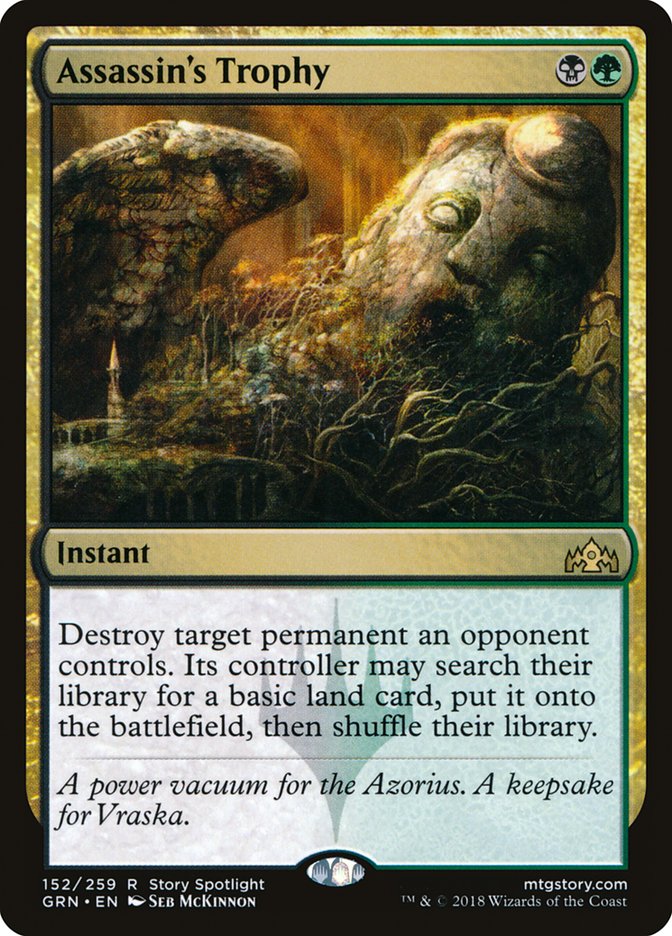

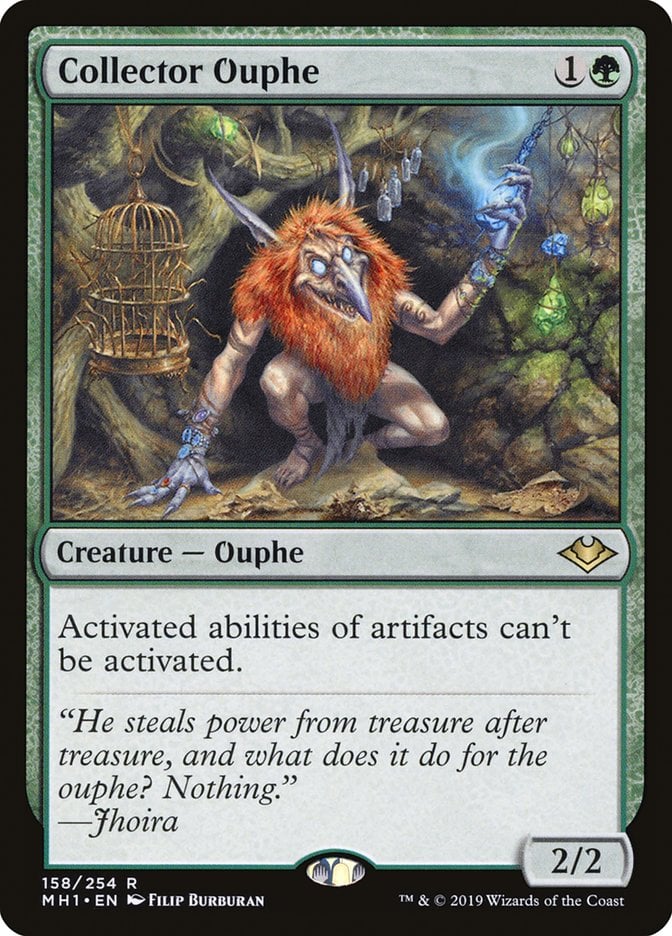
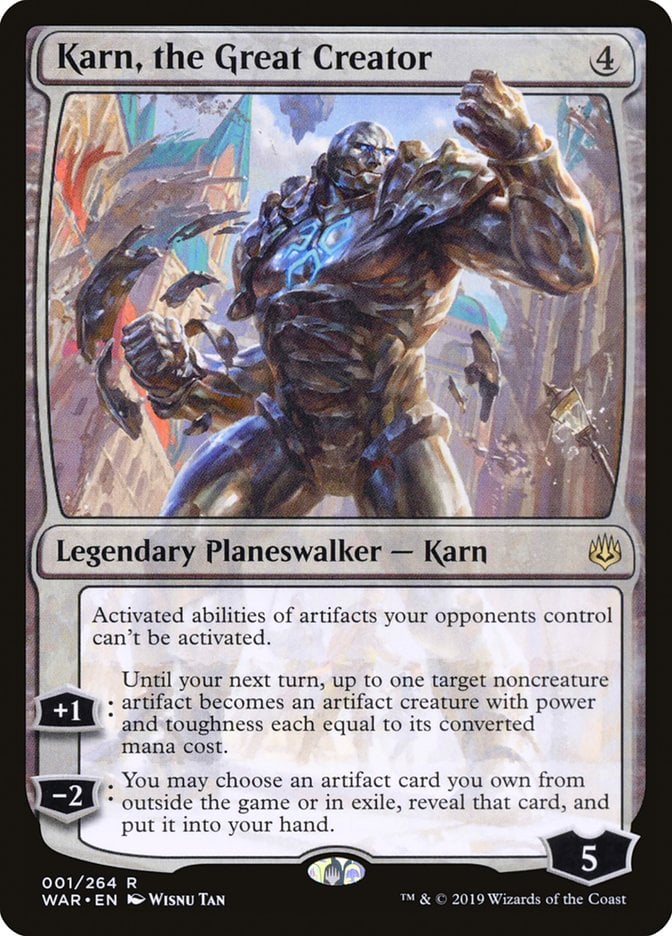

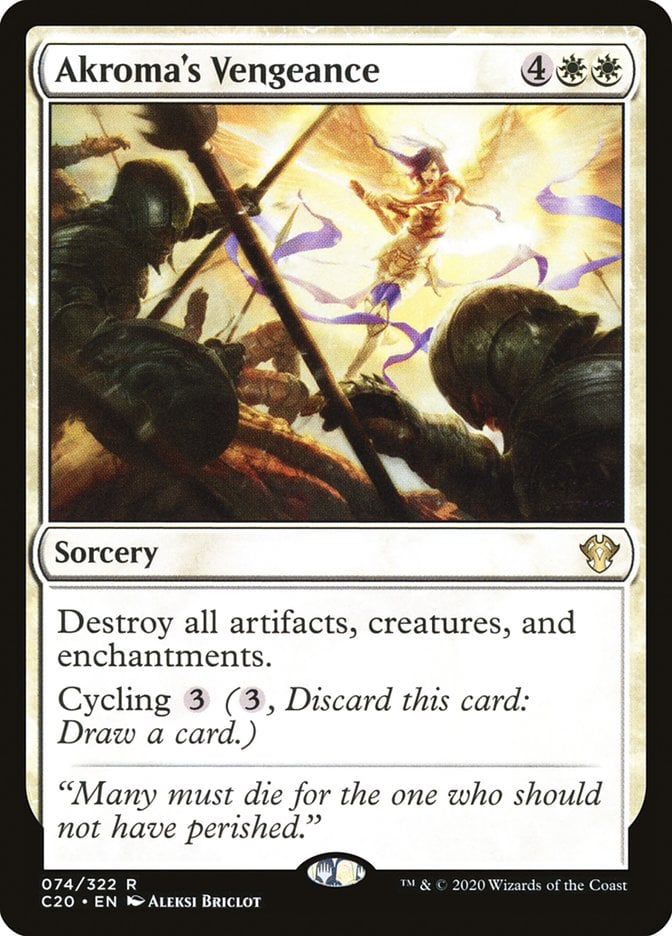
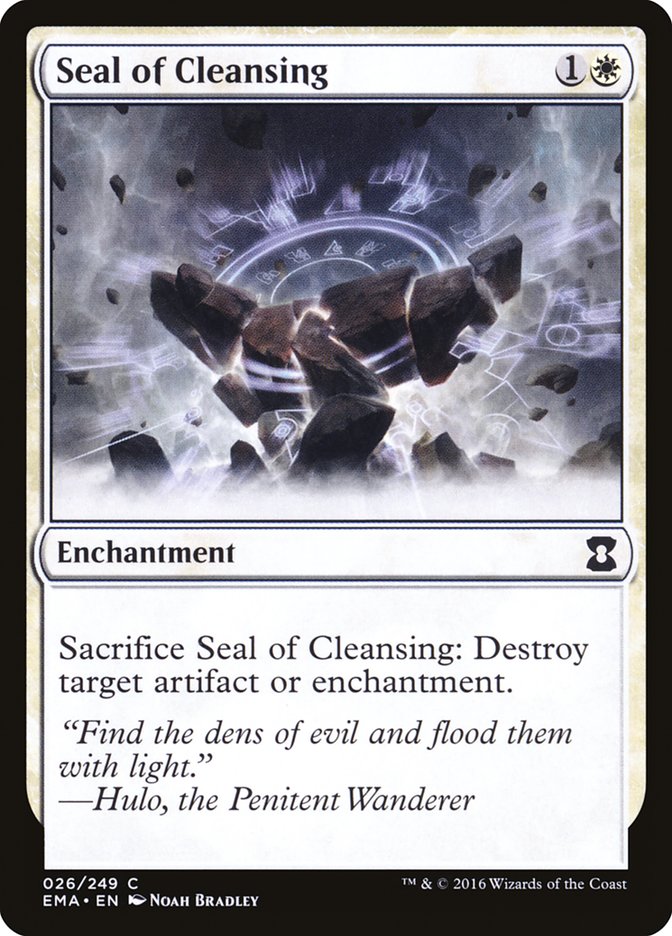

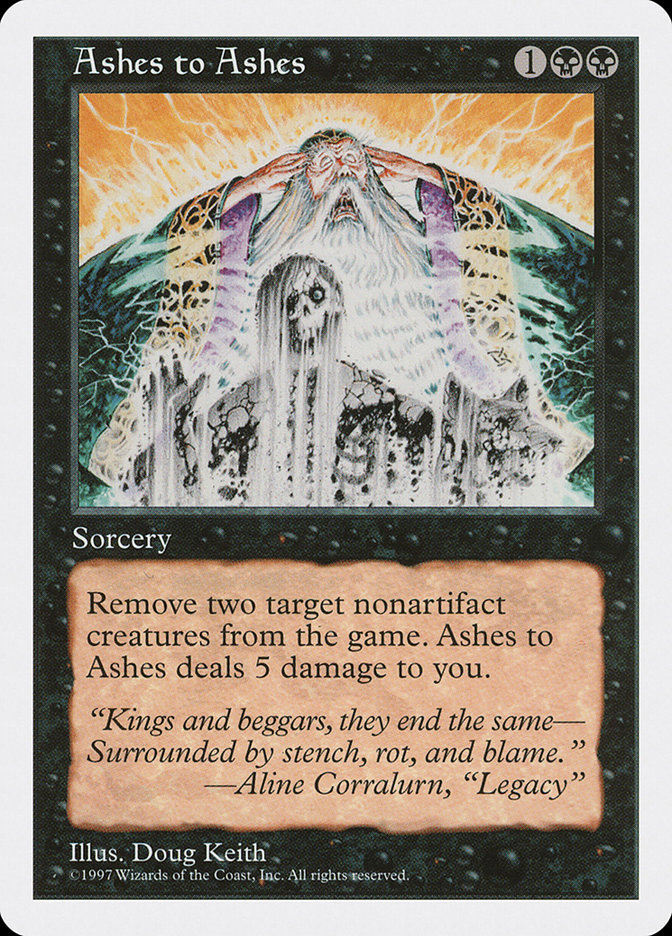
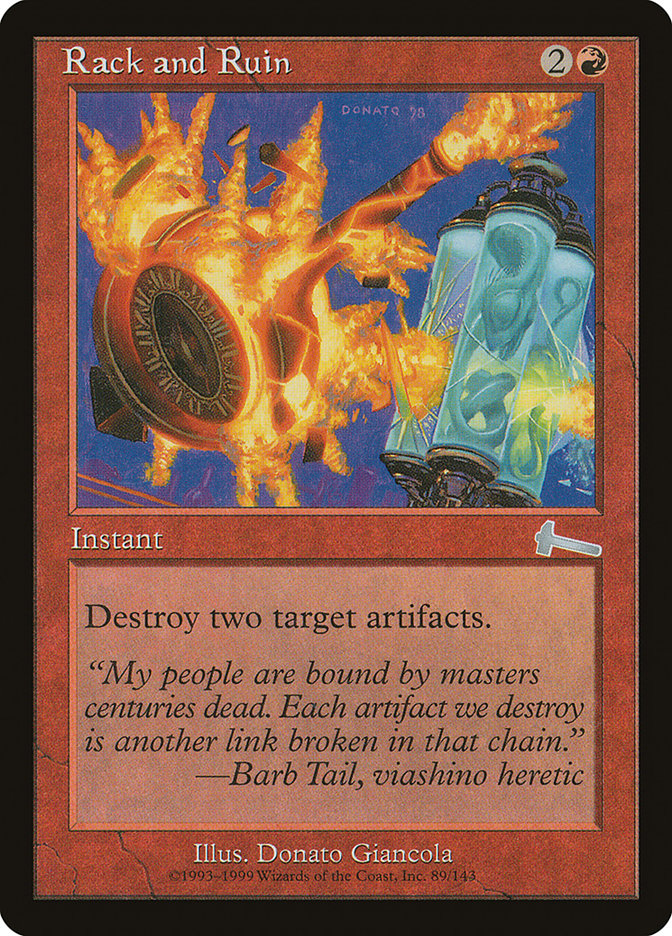



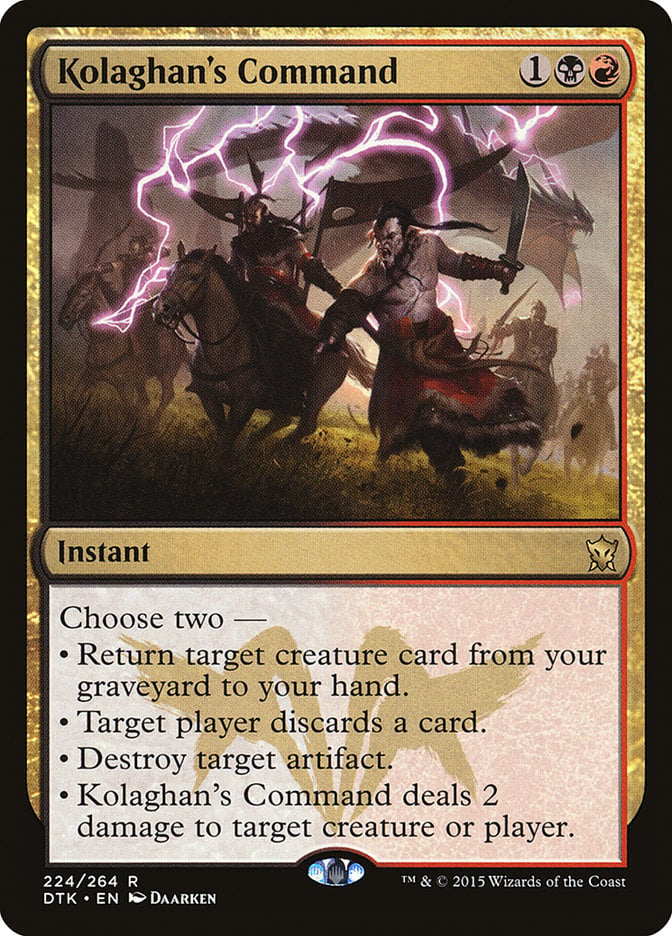
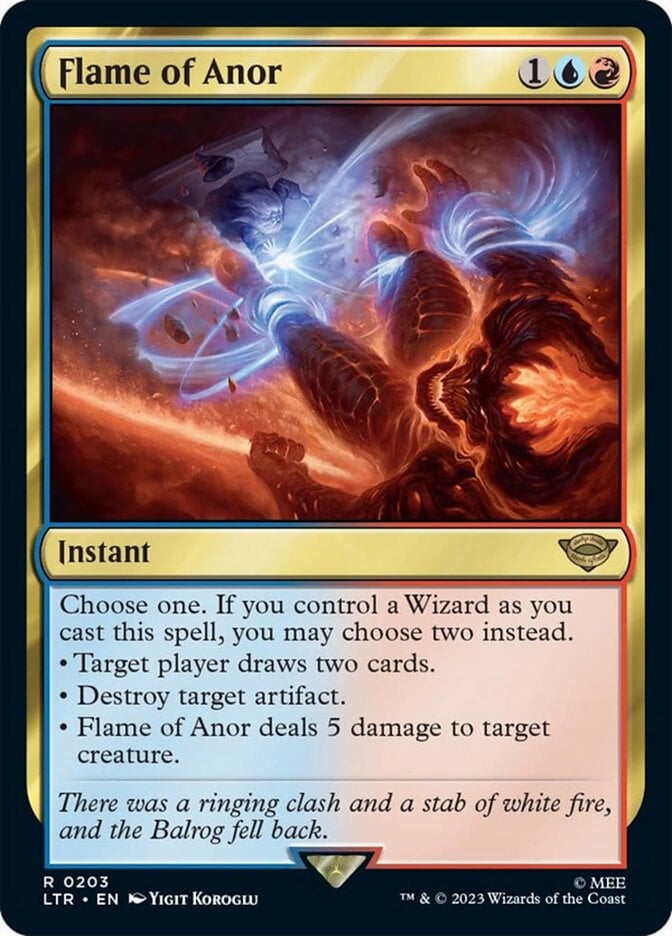
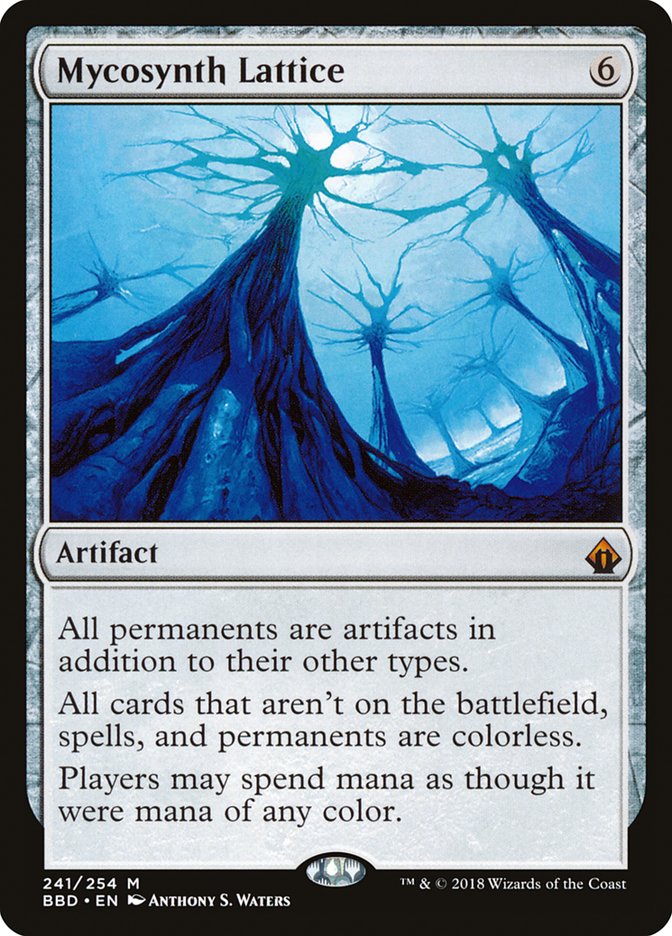
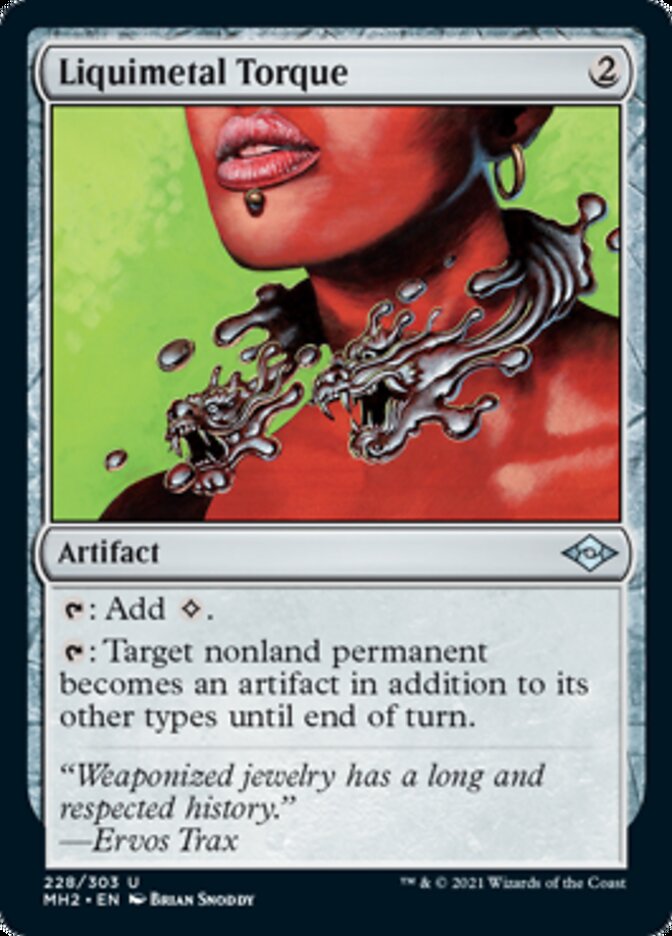
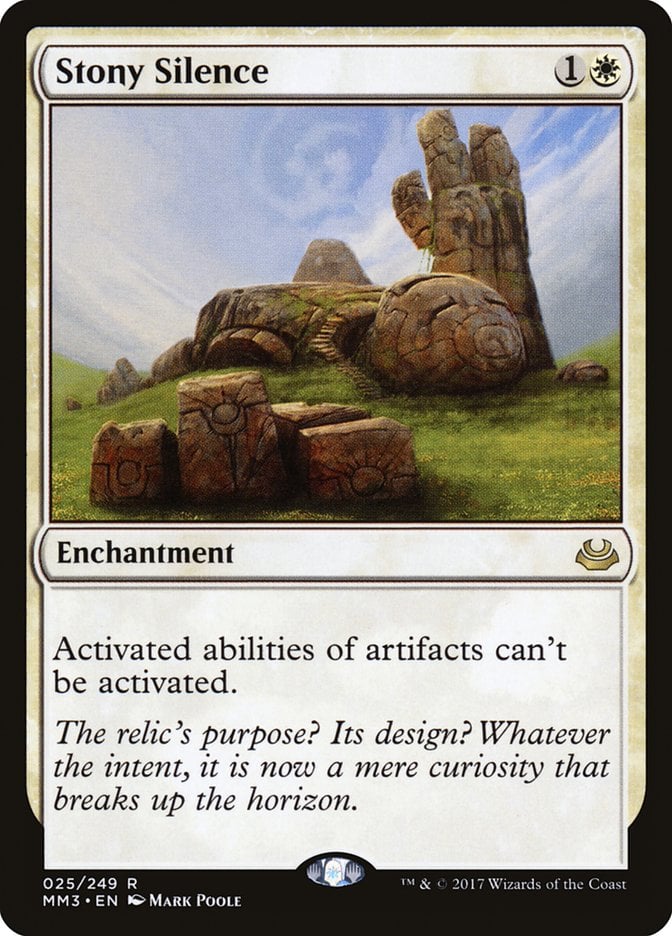
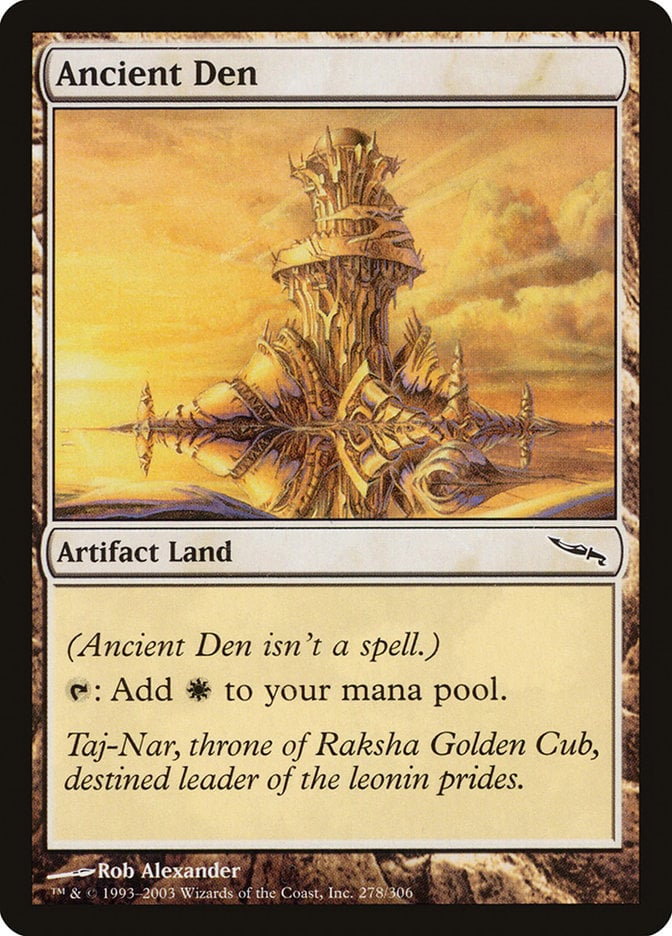
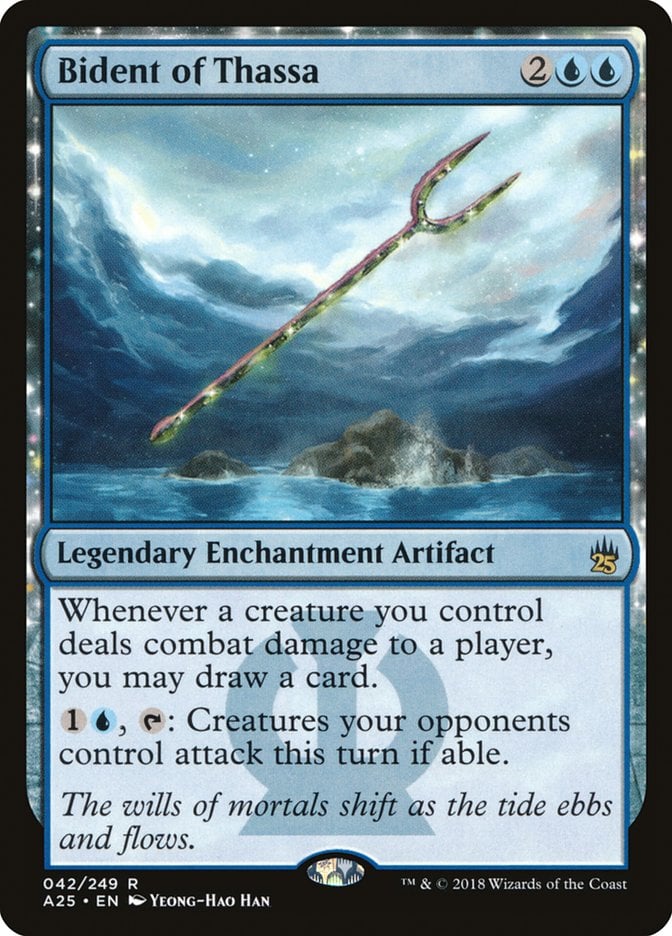
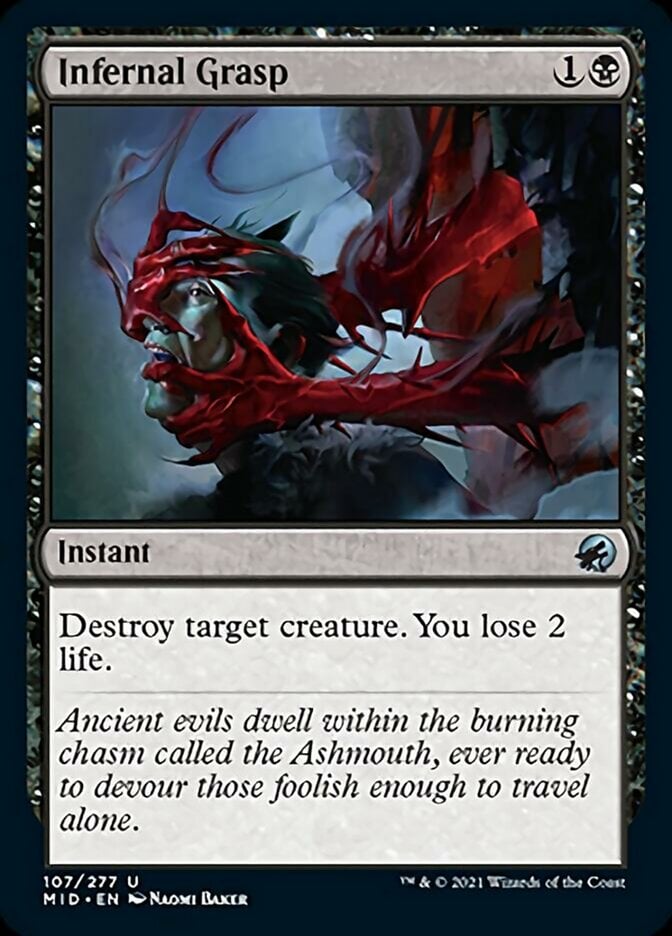

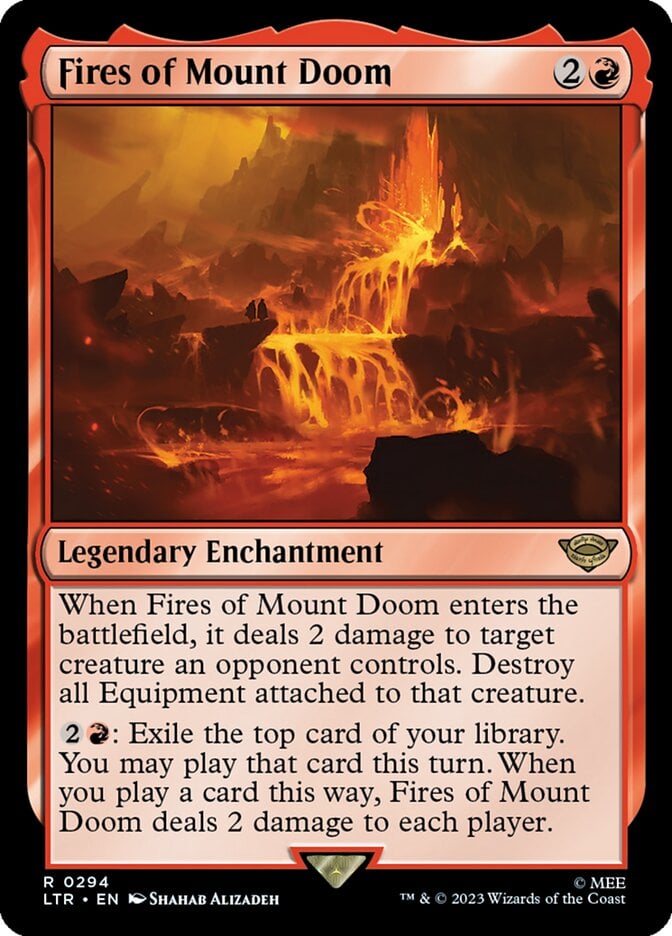
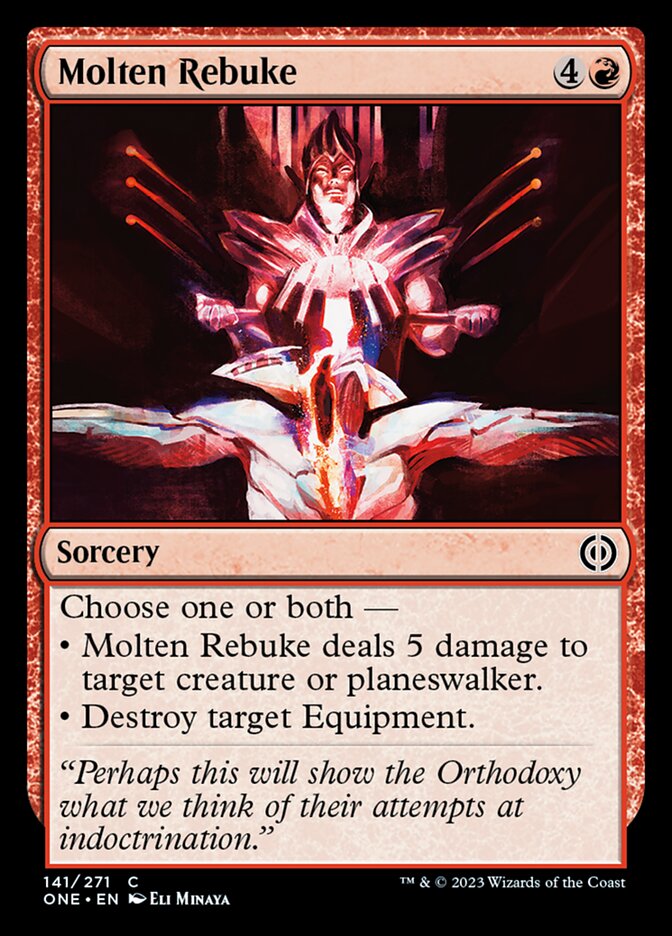

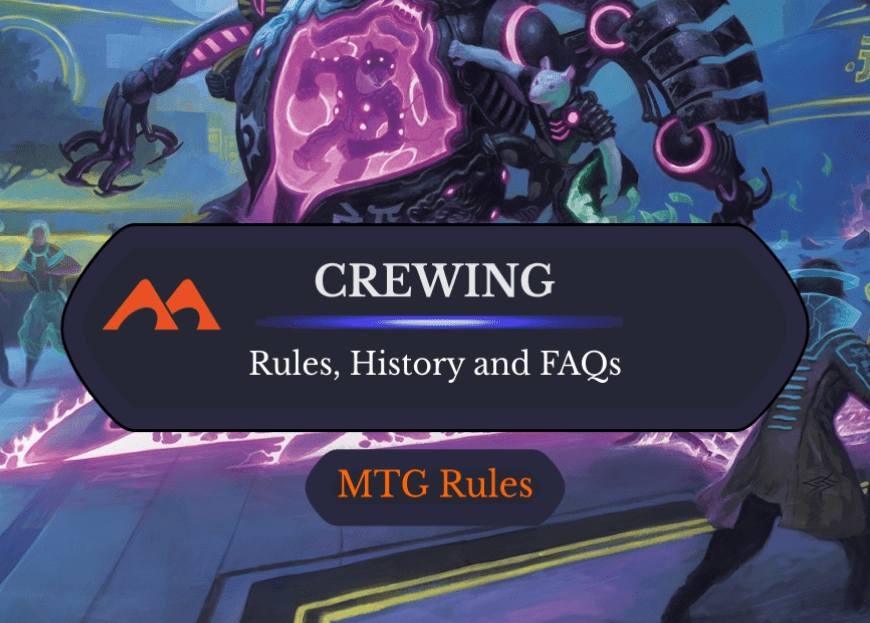
Add Comment